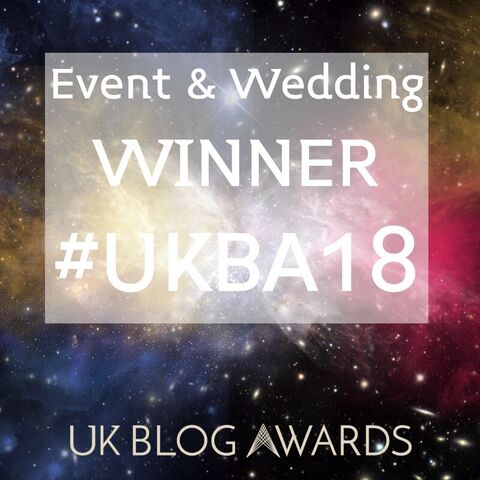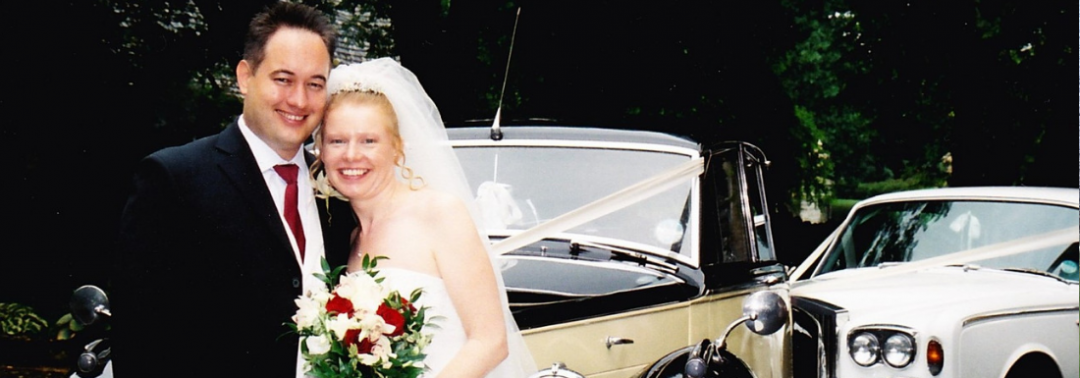
by Hanami Dream | 18, June, 2021 | blog, traditions
I remember feeling quite anxious about the calendar flipping over to the year 2000. We weren’t quite sure what would happen when it got to midnight on New Year’s Eve. This didn’t stop me partying like it was 1999 (Prince would’ve been proud of me) but I was relieved that nothing untoward happened when we joined not only a new decade, a new century, but also a new millennium.
Thankfully the Y2K computer worries didn’t bring down massive worldwide infrastructures (and we hope that fixes are in place to avoid something similar in 2038 happening too).
weddings through the decades
My look back at weddings throughout the decades has continued and I am now taking a look at a real wedding nearly 16 years ago in 2005. Even in the recent past, we can still take inspiration which helps with wedding planning in the future.
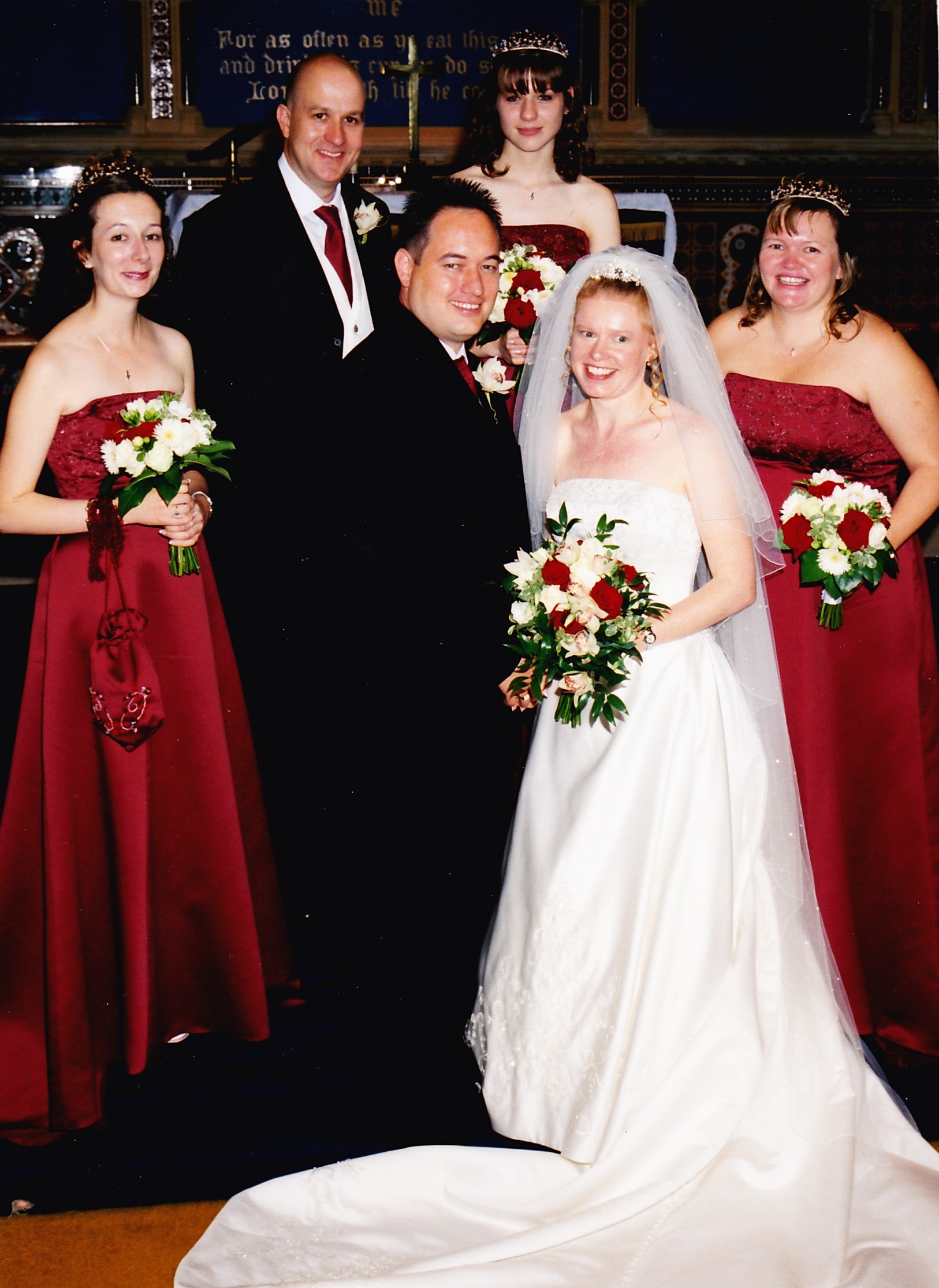
Paul Viney Photography
Britain in 2005
In 2005, employment was at a record high with unemployment benefit claimants the lowest it had been for thirty years.
A general election saw The Labour Party returning to power, with Tony Blair as the longest-serving Labour Prime Minister. Meanwhile David Cameron, MP for Witney, was elected as Leader of the Conservative Party.
The Gender Recognition Act 2004 came into effect, allowing transsexual people to have their reassigned gender legally recognised by law.
Sadly a series of terrorist bombings went off on three London Underground trains and a fourth bomb exploded on a bus later in Tavistock Square in July of 2005. Whilst British Airways grounded all flights due to a baggage handler strike.
In addition, the aftermath of a horrendous tsunami from the previous December (Boxing Day 2004) in the Indian Ocean was still affecting people.
inventions of 2005
The most notable advancement of the year was the introduction to chip and pin in our country, YouTube was founded in February and Reddit in June (with Facebook launching the year before).
Camera phones were just taking off, people could store things on USB flash drives, blue tooth was becoming more popular, along with BluRay discs, and we listened to music on ipods.
Whilst J. K. Rowling’s novel Harry Potter and the Half-Blood Prince was taking the world by storm.
highlights of 2005
Ellen MacArthur sailed around the world; Prince William graduated from the University of St Andrews; the England cricket team won The Ashes; we celebrated 400 years since the Gunpowder Plot with Guy Fawkes; and pubs in England and Wales could now be open for 24 hours.
Doctor Who was revived for the first time in 16 years, whilst Jamie Oliver battled against Turkey Twizzlers for school meals.
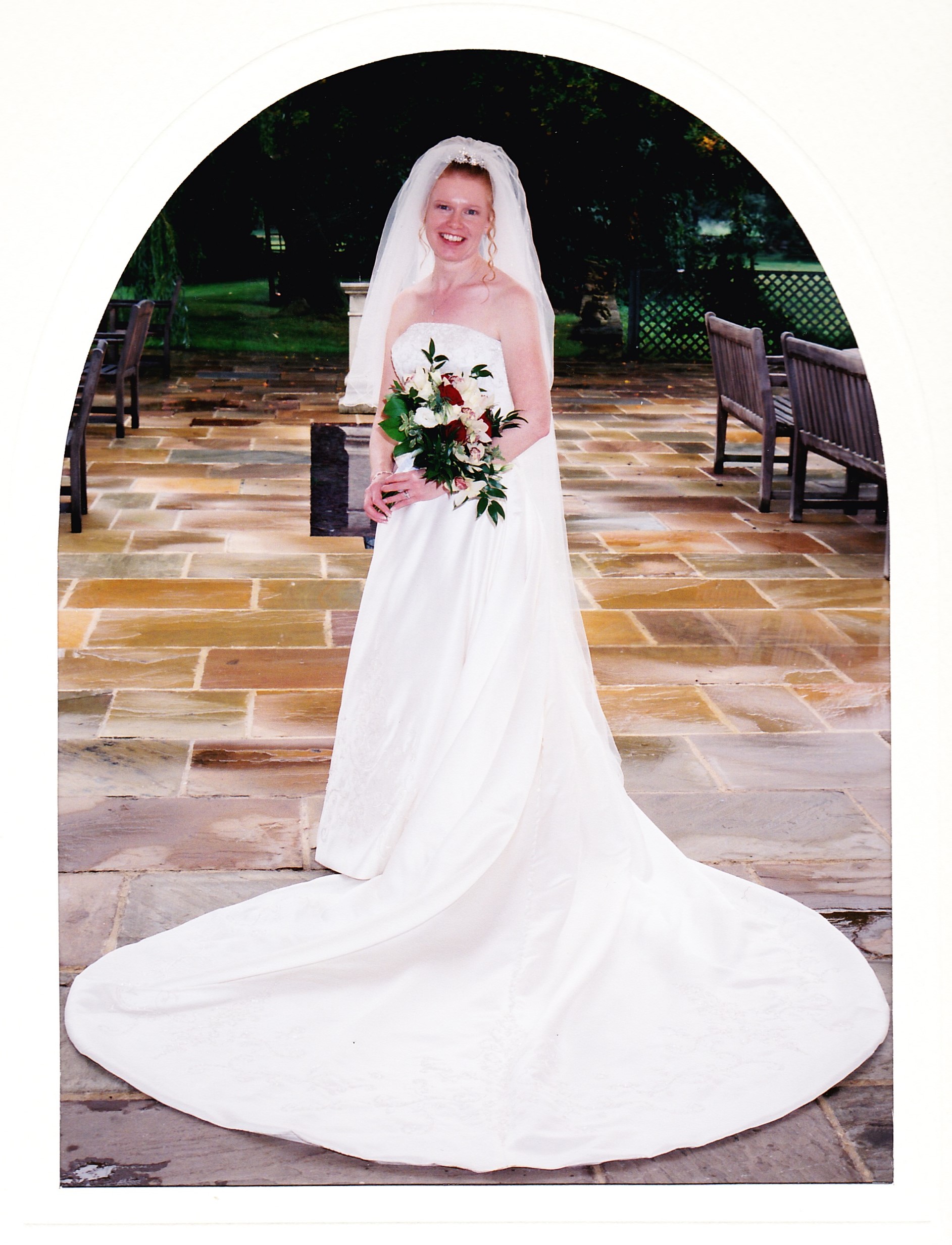
Paul Viney Photography
wedding trends in the 2005
At the end of 2005, The Civil Partnership Act 2004 came into force, which grants same-sex couples similar legal rights to those of married heterosexuals.
The Prince of Wales married Camilla Parker Bowles on Friday 8 April 2005 in a 20 minute civil ceremony at Windsor Guildhall followed by a blessing at St George’s Chapel, Windsor Castle. Other celebrity weddings of 2005 included: Donald Trump and Melania Knauss; Heidi Klum and Seal; Michael Owen and Louise; Katie Price and Peter Andre; Aston Kutcher and Demi Moore; and Ben Affleck and Jennifer Garner.
Previously in 2001, “Friends” fans finally got to see Monica and Chandler get married in the final episode of series 7. And the popularity of films about weddings continued, including The Wedding Crashers in 2005.
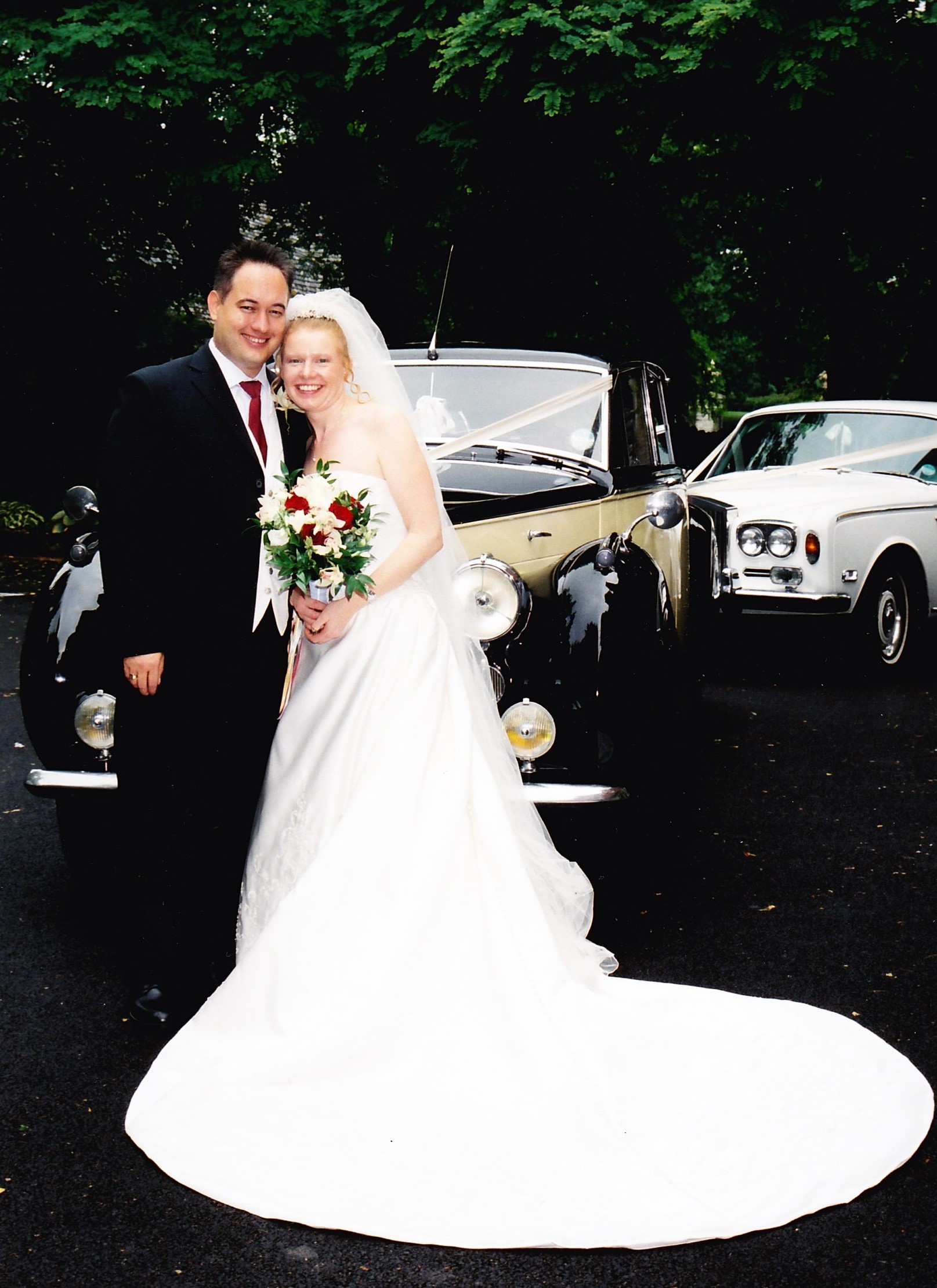
Paul Viney Photography
Millennium couples were spending more on their wedding celebrations at nearly 32 times the national weekly wage (of £532.34) with an average wedding costing around £17,000. They had probably saved for around 4 years to pay for their big day and they were more likely to have not received financial help with their wedding costs.
The average cost of a wedding dress was £825, and they were often strapless or sleeveless in the 2000s due to weddings being more secular and not under strict religious dress codes. Dresses were also shinier (in satin or taffeta) as well as adorned with lots of bling on bodices.
Couples would invite around 96 guests, with the family home being a typical location for the wedding reception. Disposable cameras were a popular wedding favour and the cupcake tower was a massive trend.
If you got married in the 2000s then you probably would’ve enjoyed a hog roast.
weddings in 2005
In 2005, there were 247,805 marriages in England and Wales (compared to 245,519 in 2015). There were 33.6 men marrying per 1,000 unmarried males and 31.1 females. The number of weddings has steadily declined over the years.
The average age of men getting married in 2005 was 36.22 and 33.5 for women (which continues to steadily rise).
35% of weddings took place in a religious ceremony in 2005 (which continues to decline).
real wedding from 2005
I am delighted to share another special day of an incredibly skilled local supplier, Susie Grist who married Mark on 10th September, 2005.
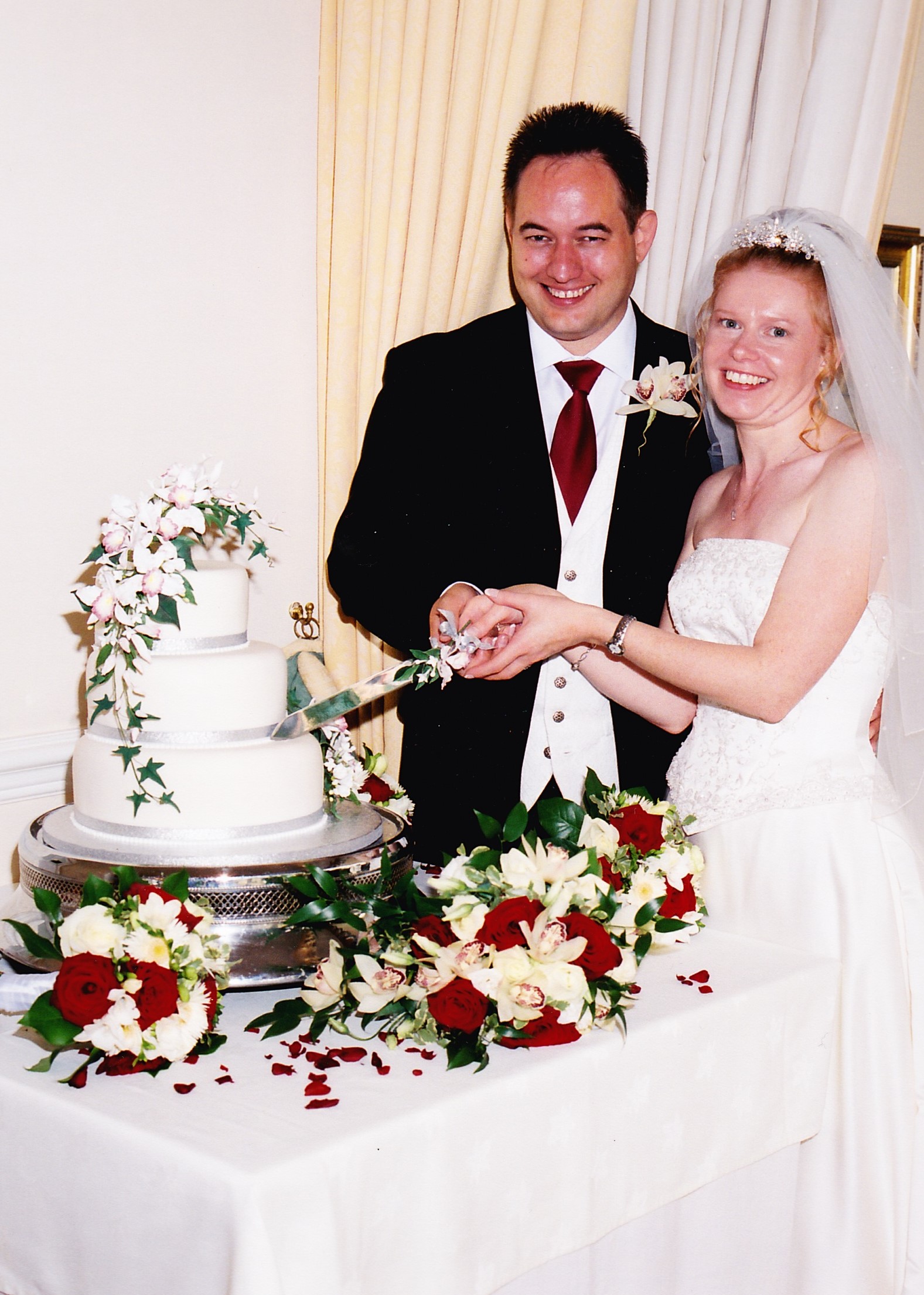
Paul Viney Photography
Susie recounts:
‘It drizzled with rain in the morning that got heavier as the morning went on and by the time my car arrived at the church it was absolutely pouring. There was a river running along the curb. We had hired white golf umbrellas just in case and the Ushers made a tunnel with the umbrellas for me and my Dad to get into Trinity Church, Abingdon.
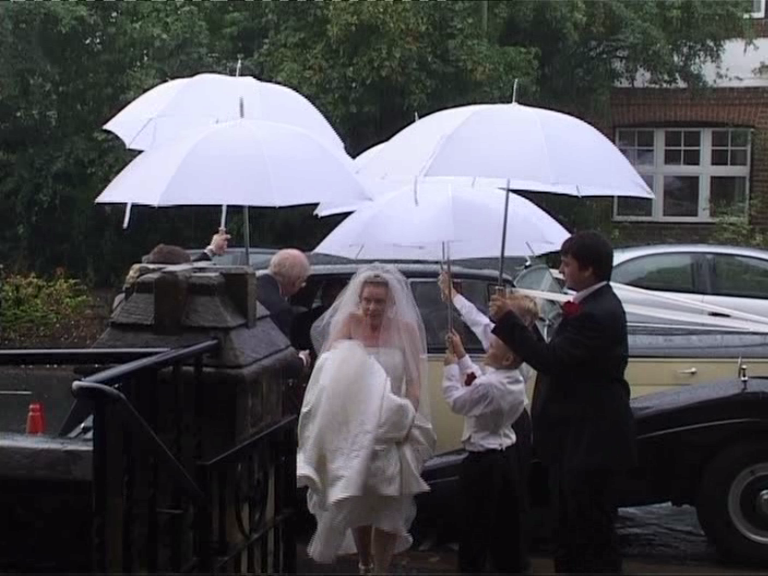
We had a church service with hymns ‘Love divine, all loves excelling,’ by Charles Wesley (1707 – 1788) and ‘The grace of life is theirs’ by Fred Pratt Green from 1970. A reading from ‘Captain Corelli’s Mandolin’ was read by a good friend of Mark’s and his Dad is a retired Methodist Minister who did the reading of 1 Corinthians 13. Due to the rain we ended up having photos taken in the church. Although it had stopped at this point the ground was very wet.
We arrived at Fallowfields Country House Hotel, Southmoor, the reception venue in sunshine to canapés and bucks fizz. We were able to have a few photos in the garden before the wedding breakfast was served.
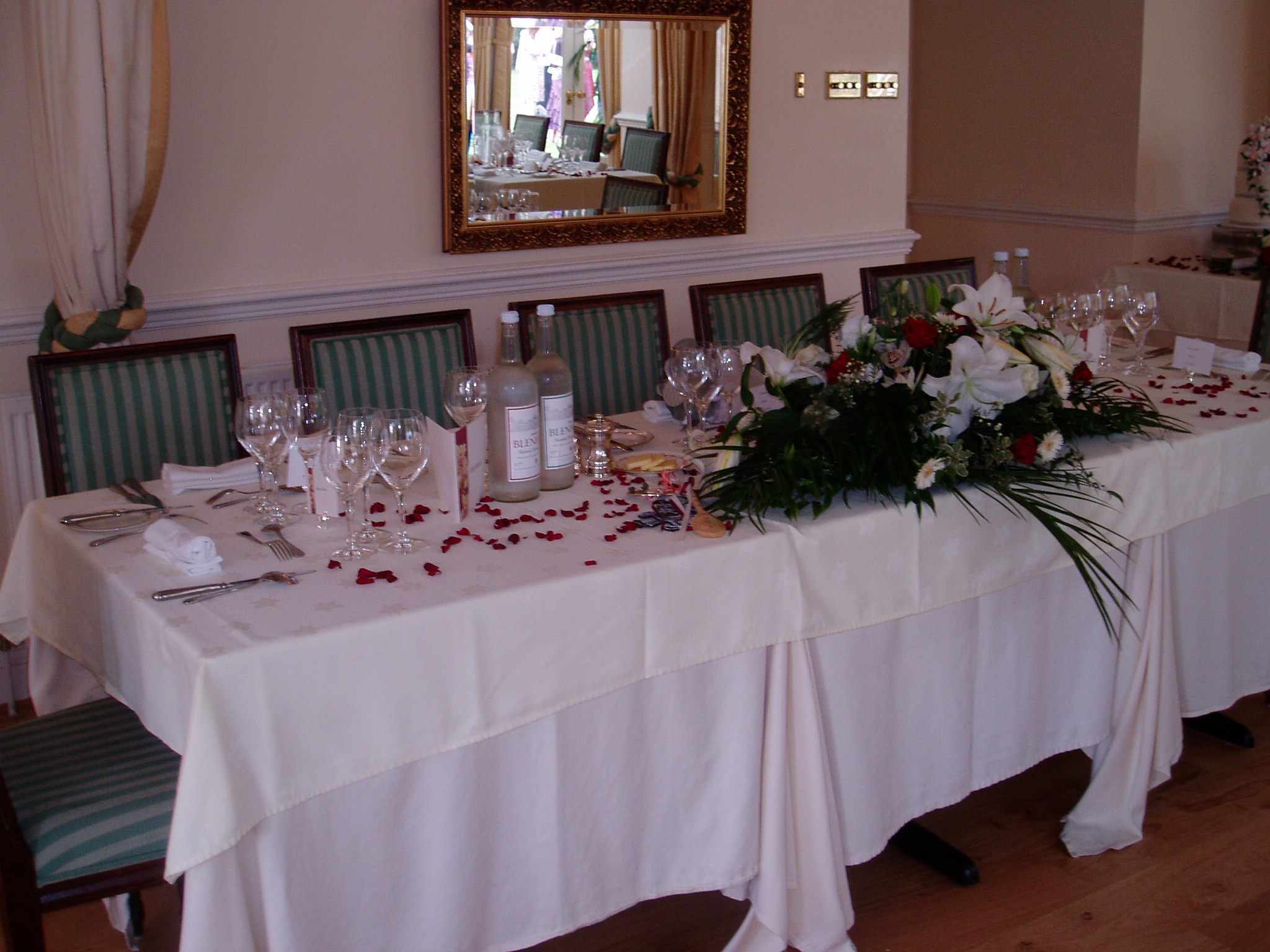
We had hoped to have a display by birds of prey but due to the weather being a bit stormy they were a bit on edge so we just had photos taken with one bird a peregrine falcon called Scarlet.
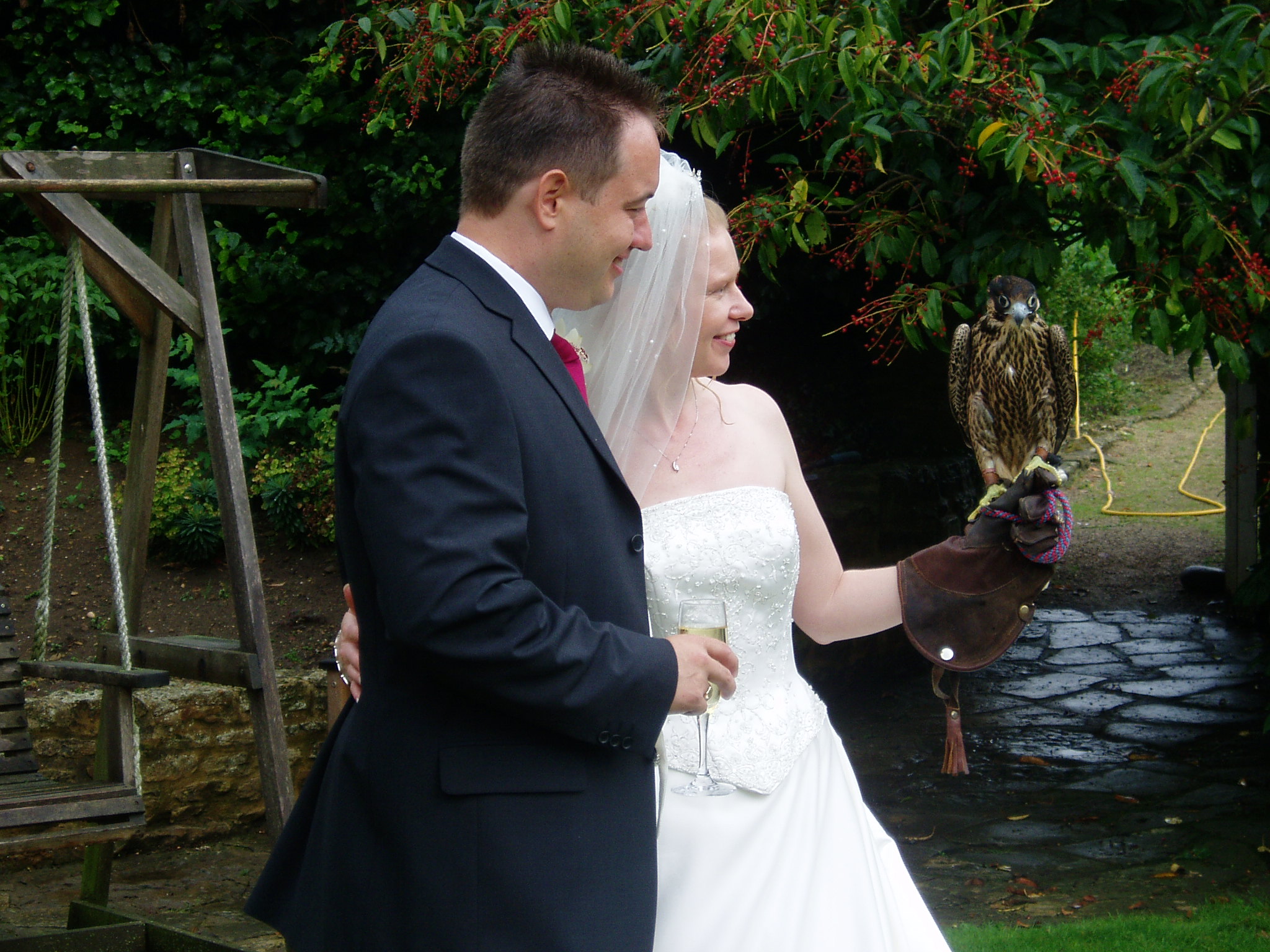
We cut the cake at 8pm to start off the evening celebrations with a disco. My Auntie made the three tier fruit cake with white icing and sugar flower decorations of cymbidium orchids, white stephanotis, white blossom and ivy.
She also made a second Victoria sponge cake with icing and two sugar figurines of me and Mark on the top.
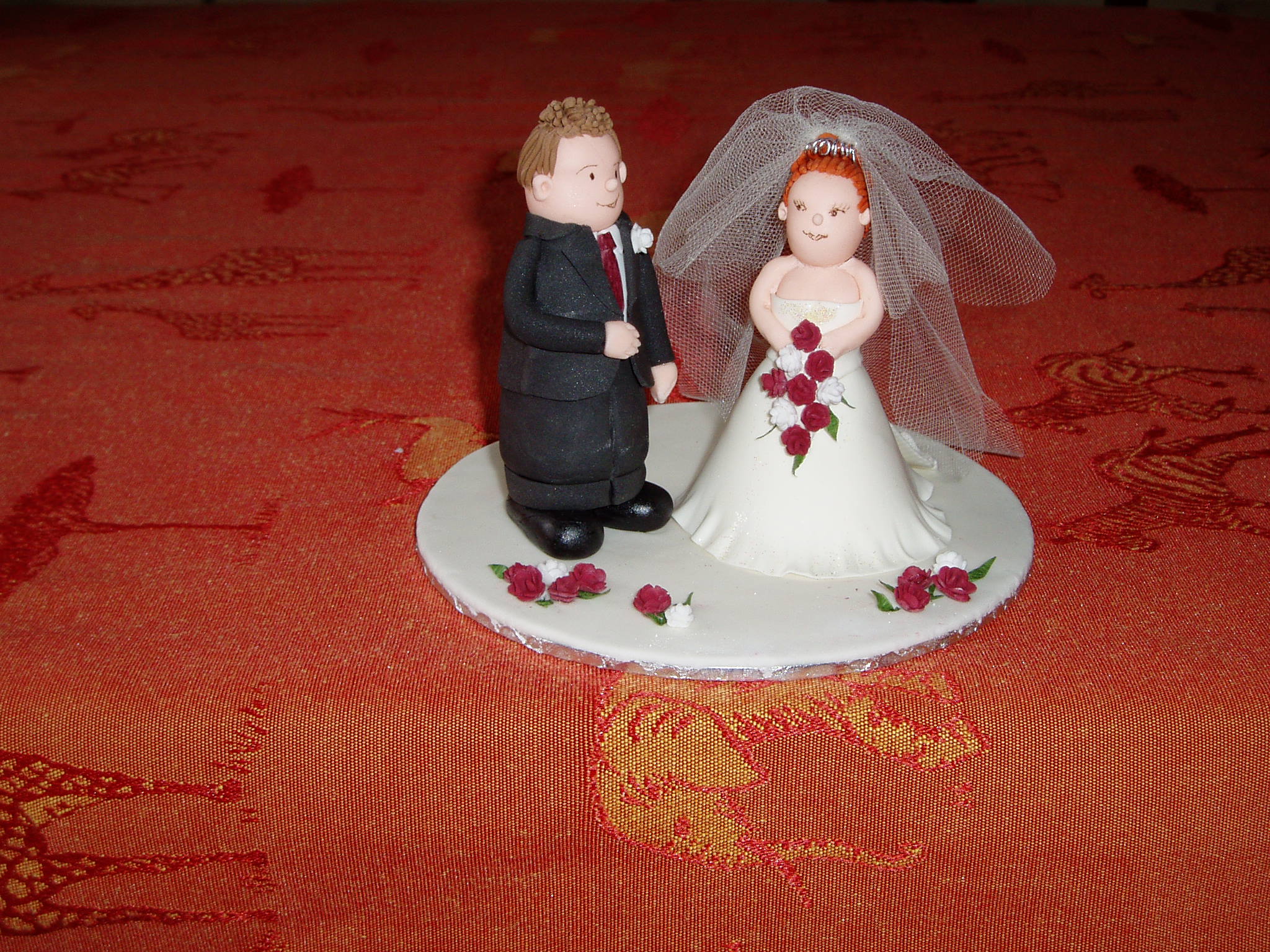
The venue did not require any decoration as it was a beautiful country house. It had a lot of ornaments and decorations of elephants and as I absolutely adore elephants it was the perfect venue.
We had 65 guests for a sit down wedding breakfast of:
STARTER
- Cream of Giant Prague celeriac with Colston Basset blue Stilton soup (v)
- Chilled greenhouse Blenheim orange melon with a soft berry compote (v)
- Pink lamb fillet baked with rosemary and presented on a mixed salad coated in beetroot oil
MAIN
- Pan seared fillet of salmon served on a bed of creamed potato with Samphire and herbs
- Loin of Welsh Mountain Lamb sliced onto rosemary layered potato with glazed shallots
- Roast breast of Gressingham duck served on a casserole of autumn vegetables
DESSERT
- Hot plum and almond crumble served with vanilla sauce and prune ice cream
- Summer fruit pudding served with a caramel basket of vanilla pod ice cream
- Strawberries and vanilla pod ice cream
Then we had an extra 35 for the evening to total 100 guests who later all enjoyed a buffet and cake.
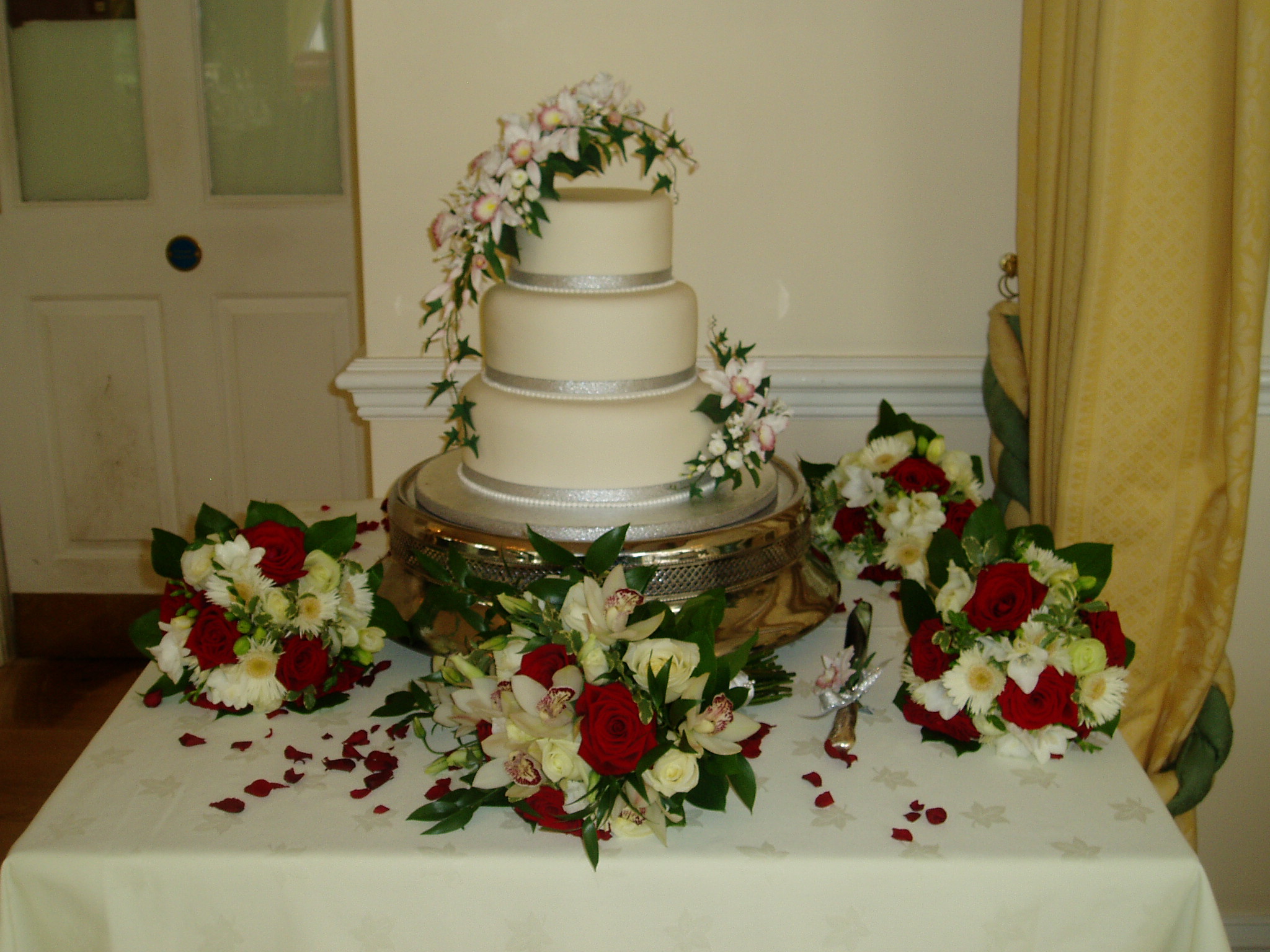
Tables were named after safari animals as we were going on safari in Botswana on Honeymoon and I am a big elephant lover:
- Elephant (top table)
- Antelope
- Zebra
- Rhinoceros
- Giraffe
- Hippopotamus
- Leopard
My father worked for a printers so we designed our own invitations using a photo of a cymbidium orchid that we had taken with the bridesmaid dress fabric in the background. This image was used for all the stationery including place cards, table names and the seating plan.
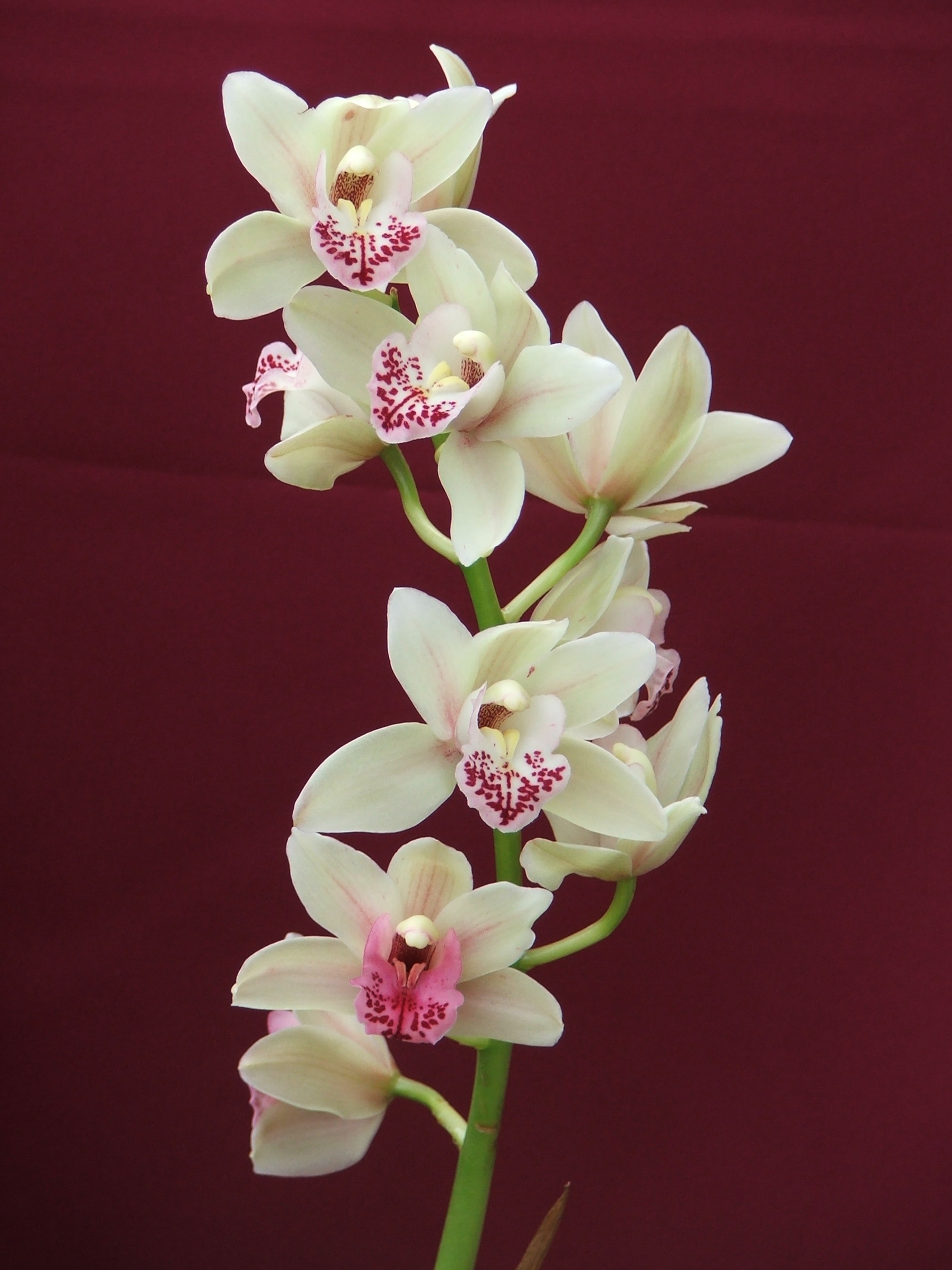
Our colour theme was burgundy and ivory, along with orchid flowers.
My bridal dress was bought from Fairytales in Witney (no longer trading). It was one of their own label dresses made by their seamstress. A strapless straight neckline bodice with a full A-line pleated skirt which looked like a separate bodice and skirt but was in fact one complete dress. The dress was embroidered and had a beaded design on the bodice and on the bottom of the front skirt and train. Plus covered buttons all the way down back from bodice to train.
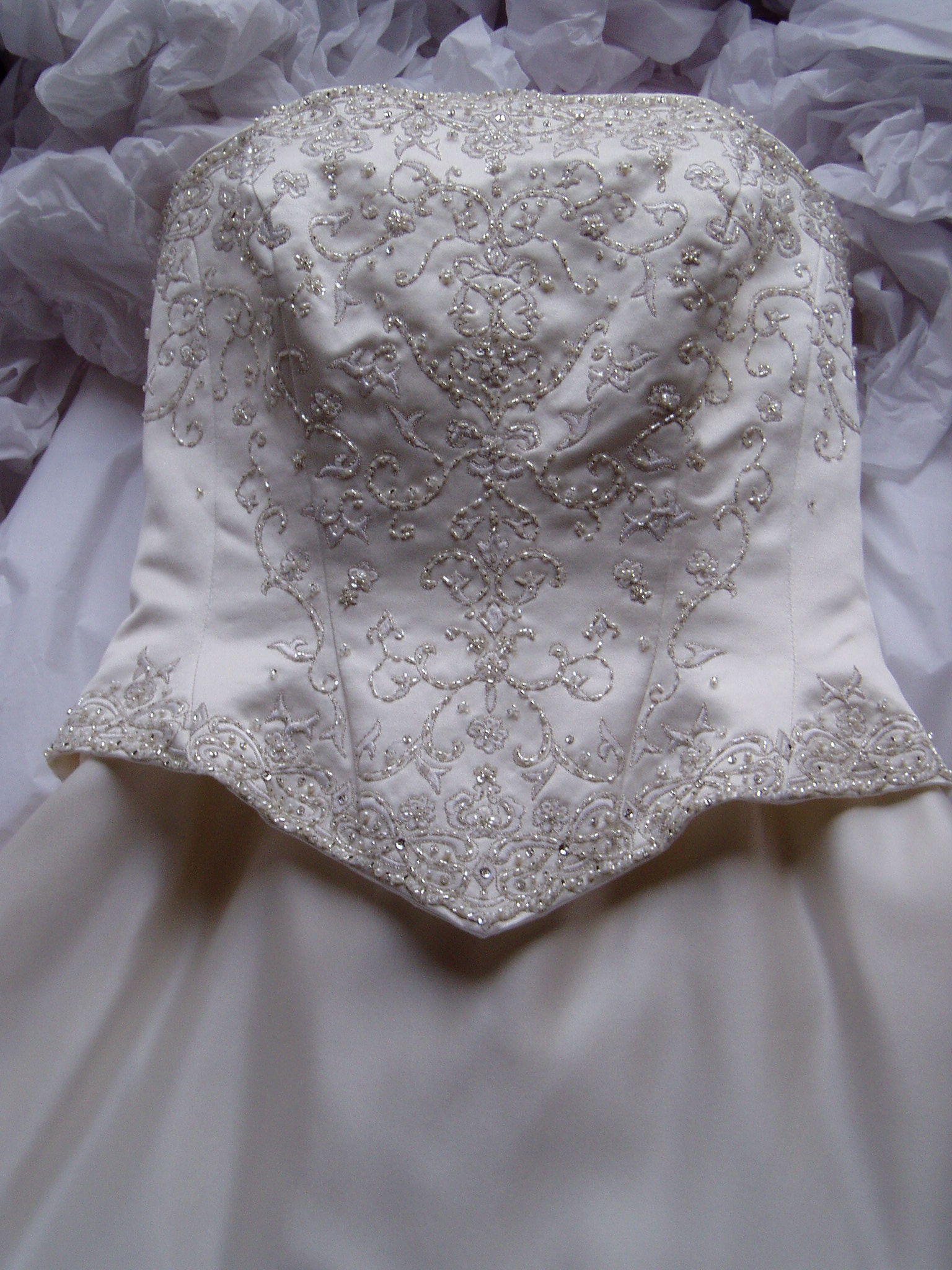
The three bridesmaids were my sister-in-law, best friend from school and the groom’s niece. They wore Alfred Angelo Burgundy satin empire line dresses with an embroidered and beaded bodice.
The groom wore a grey lounge suit from Marks & Spencer, an ivory brocade waistcoat which I made and a burgundy tie to match the bridesmaids dresses also made by me. These matched the waistcoats and ties for the best man, fathers, page boys and ushers.
My tear drop shape bouquet contained orchids, red grand prix roses, white bianca roses, white lisianthus, ruscus and beargrass. The floral spray arrangement was supplied by Wendy Madley Flowers (no longer trading). The bridesmaids had hand tied bouquets with similar flowers and white freesias and gerberas. The button holes were orchids.
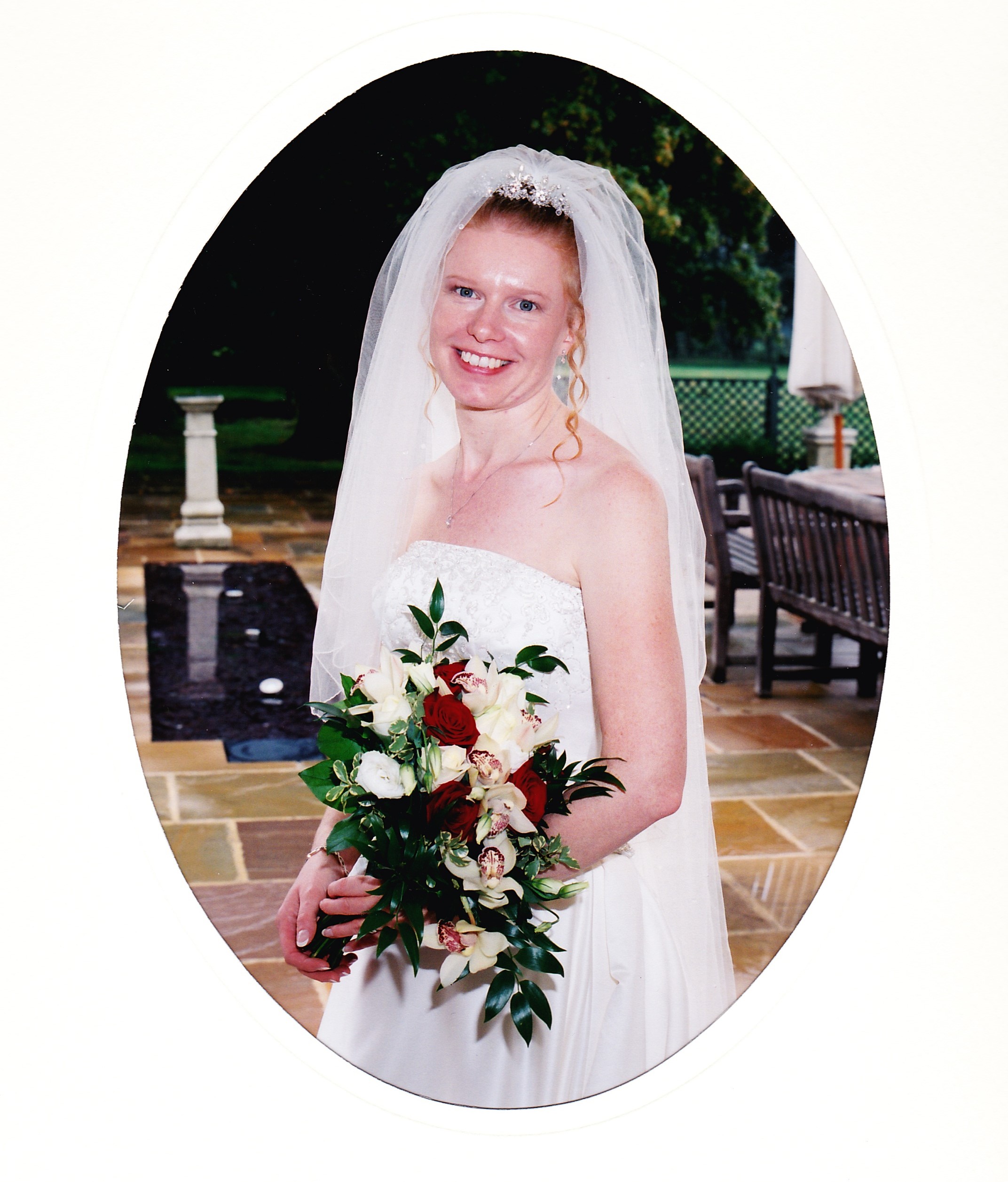
Paul Viney Photography
Plus tall vases on each table with ivory glitter stones in the bottom filled with white lilies and feather grass. These vases stood on mirror plates scattered with clear scatter crystals and the tables were scattered with red rose petals.
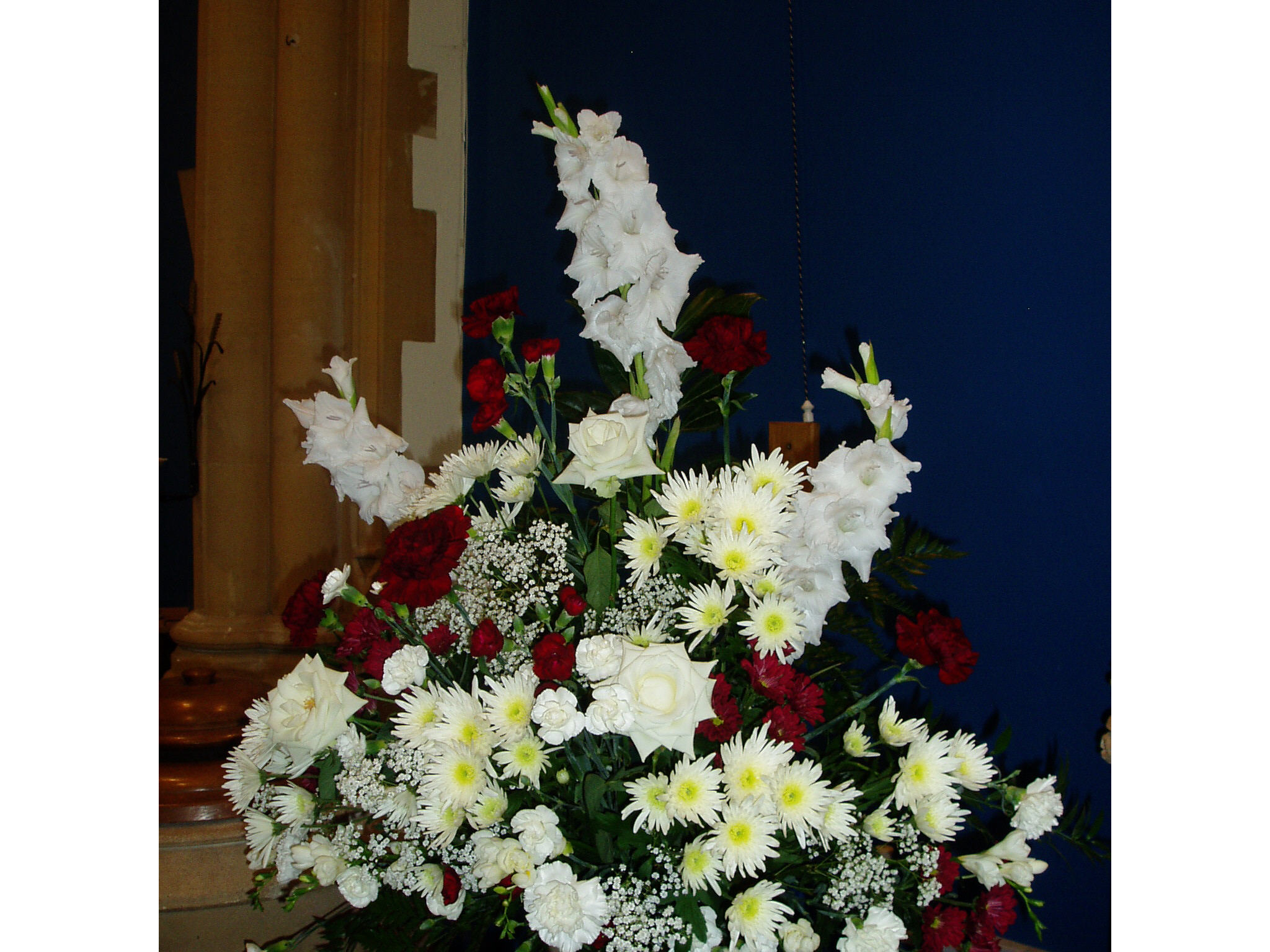
Me and and my father travelled to the church in a black and ivory 1955 ‘R’ Type Bentley HJM supplied by Platinum Wedding Cars. Whilst my mother and bridesmaids travelled in a Rolls Royce Silver Shadow.
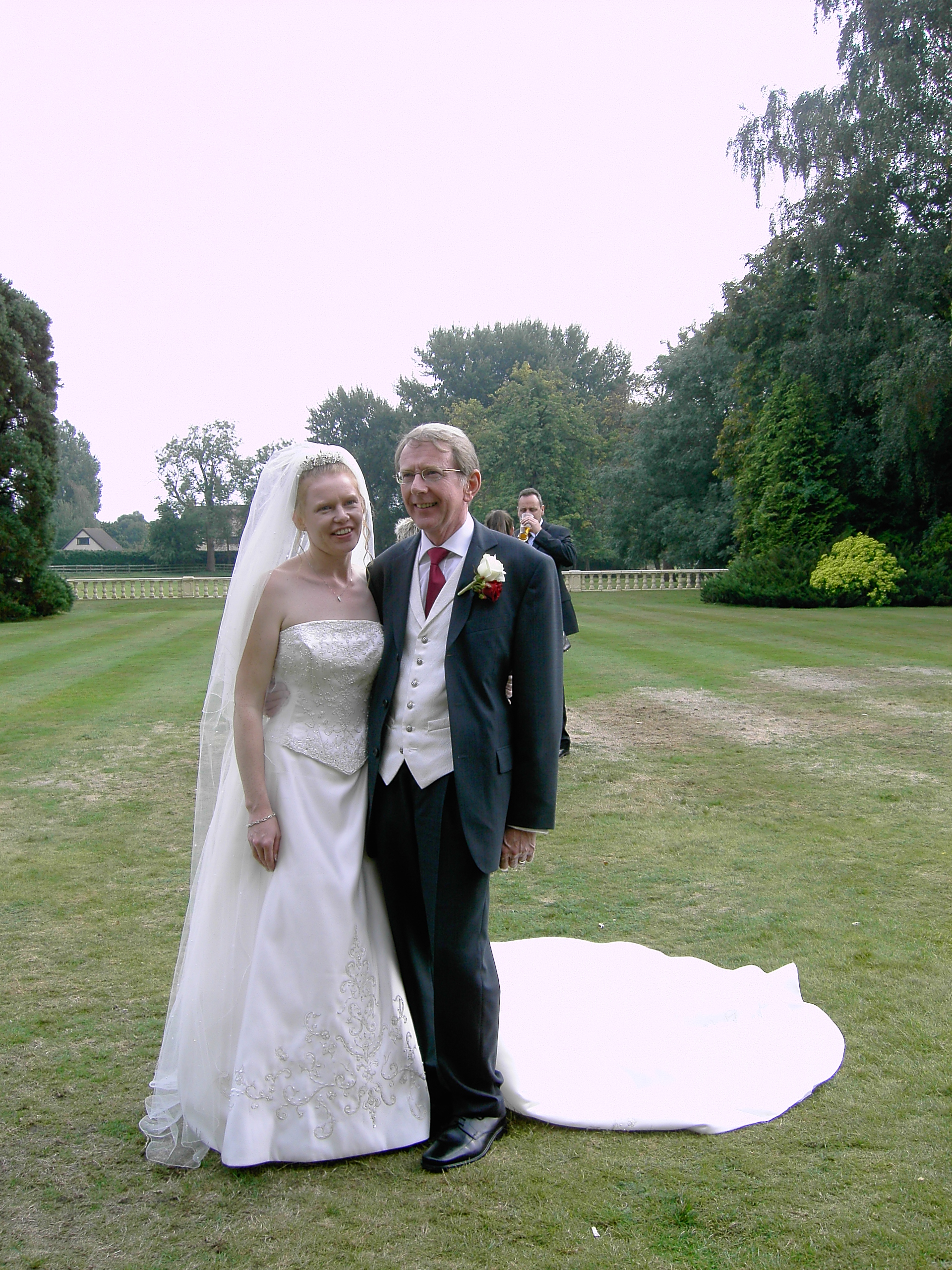
Entertainment was a disco in the evening by Regency Entertainment. We didn’t have favours but we did provide the children with gift boxes containing games, toys and things to keep them amused from a company called Smiles.
Paul Viney Photography (no longer trading) was our photographer. It was still 35mm film in those days and he was a traditional group photographer so unfortunately didn’t capture many details of the wedding. Some guests had digital cameras and took some extra photos for us. We also had a videographer, Howard’s Video Service (who I’m not sure is still trading either).
For our honeymoon we went on safari in Botswana and then a beach holiday in Mauritius.’
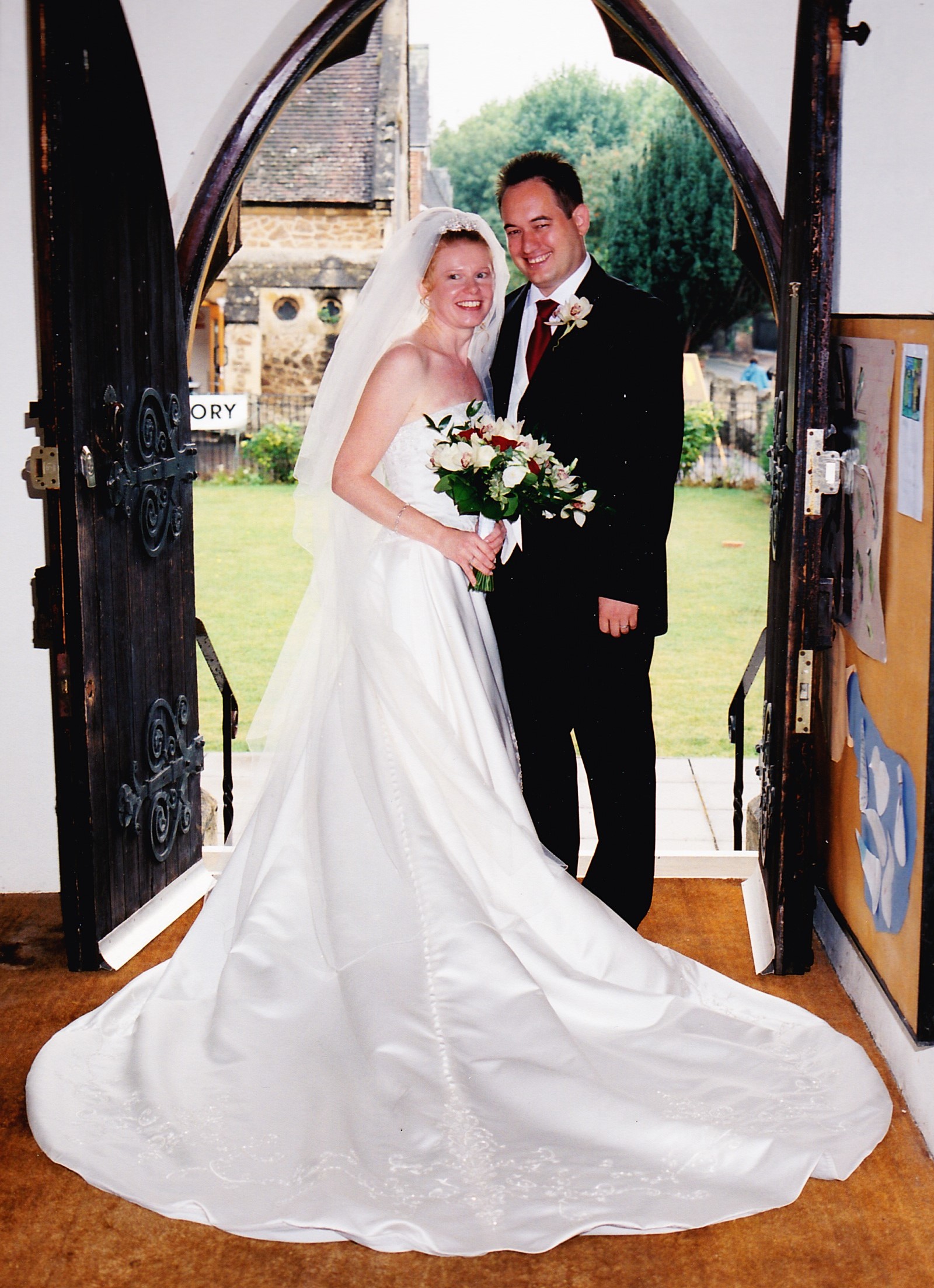
Paul Viney Photography
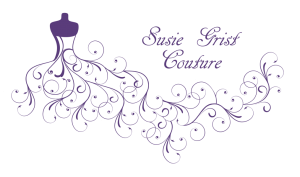 About Susie Grist Couture
About Susie Grist Couture
Susie Grist Couture specialises in designing and making individual bespoke wedding gowns. Based in Abingdon-On-Thames working from a home studio.
She has over 18 years of professional sewing experience and has been designing wedding dresses for nearly 6 years. She makes bridal gowns, bridesmaids and flower girl dresses and even outfits for mothers.
 susiegrist
susiegrist
 @susiegristcouture
@susiegristcouture
 @susiegristcouture
@susiegristcouture
summary
The 2000s saw the era of shiny, embellished, and strapless dresses. Country house hotel receptions were completed with cupcake towers, disposable cameras and evening reception hog roasts. The cookie cutter approach to weddings was starting to dwindle as more personalised elements were creeping in and more couples were paying for their own weddings. Social media was just starting to become a part of our lives and influence weddings, whilst couples could now create their own playlists on ipods.
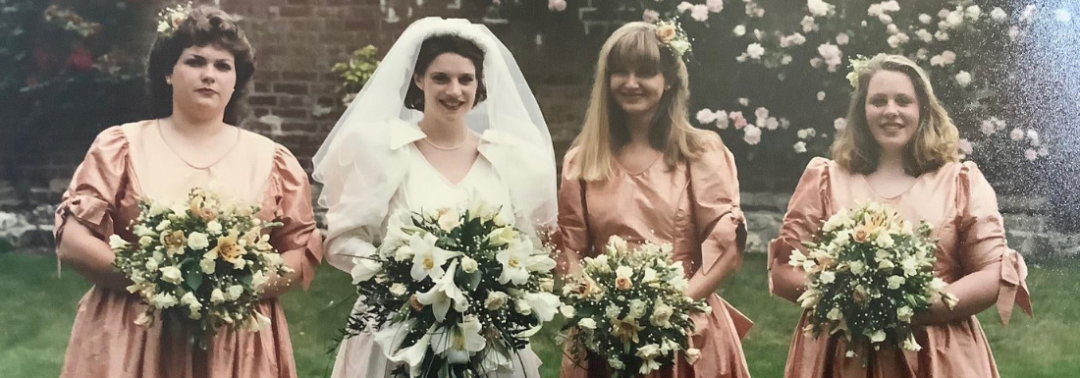
by Hanami Dream | 14, November, 2020 | blog, traditions
The soundtrack to my lockdown since March has been Fearne Cotton’s Sounds of the 90s on BBC Sounds. These tunes and memories from the 1990s have accompanied me whilst gardening, doing chores around the house or out for runs. These songs of my teenage years have brought back wonderful memories, including my University days dancing in the union bars and clubs.
weddings through the decades
My reminiscing has continued and I am now taking a look at a real weddings 27 years ago in 1993. Take a look at other real weddings throughout the decades to look at differences, similarities and things we can learn to help with wedding planning now.
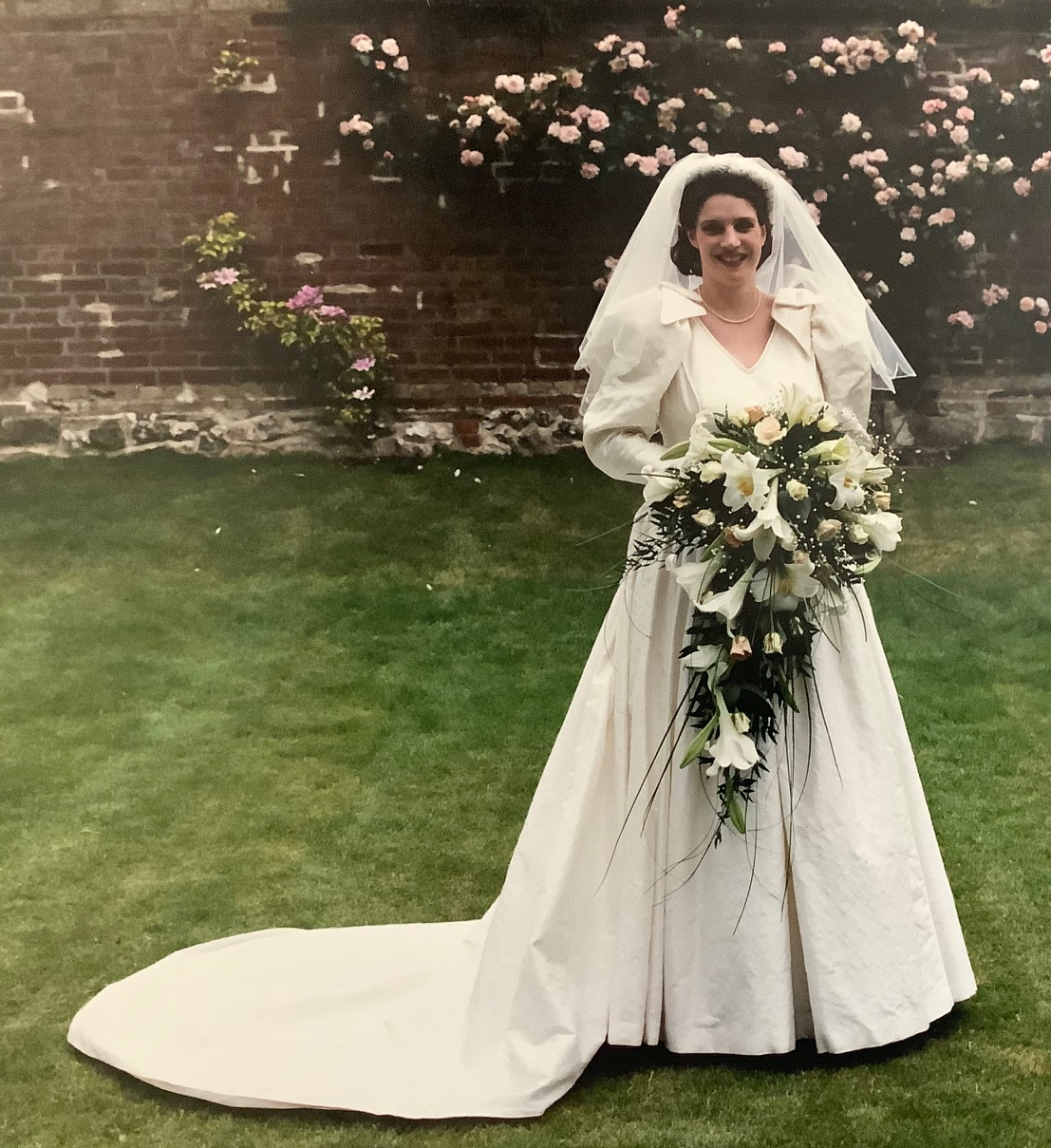
Britain in 1993
Back in 1993, Britain was finally seeing an economic recovery after 3 years of recession. John Major was the Prime Minister, who introduced a nostalgic ‘back to basics’ campaign appealing to traditional values such as “neighbourliness, decency and courtesy”. Unemployment started to fall for the first time since May 1990 and interest rates were lowered to 6% – the lowest since 1978.
Meanwhile, sad news of the year included an oil tanker running aground near the Shetlands, bombings in Warrington and Bishopsgate, two high profile murder cases, and the separation of Princess Diana and Prince Charles as she leaves public life (mirroring Prince Harry and Meghan’s story of this year).
inventions of 1993
Notable products to come to market in 1993 included the Ford Mondeo, the Vauxhall Corsa (which was my first car in 1999!), Beanie Babies, fidget spinners, Dyson’s first bagless vacuum and Teletex replaced Oracle.
highlights of 1993
Buckingham Palace opened to public and the Channel Tunnel opened (I still remember my first trip on the Channel Tunnel train and overhearing a little girl saying she could see an octopus swimming past!)
In music, the big selling singles were Meatloaf’s I’d Do Anything For Love (But I Won’t Do That), UB40’s I Can’t Help Falling in Love With You, Whitney Houston with I Will Always Love You and Snow’s Informer. The year’s Christmas number one is an all-time classic: Mr Blobby by Mr Blobby
TV shows of 1993 included: Friends, Dawson’s Creek, Gladiators, The Brittas Empire, The Crystal Maze, Noel’s House Party, X Files, The New Adventures of Superman, Peak Practice and Diagnosis Murder.
The big films of the year were Jurassic Park, The Fugitive, Sleepless in Seattle, Mrs Doubtfire, Philadelphia, Schindler’s List (which won the best picture Oscar) and the wedding films that people got obsessed over were: Father of the Bride, and not forgetting the stammering Hugh Grant in Four Weddings and a Funeral.
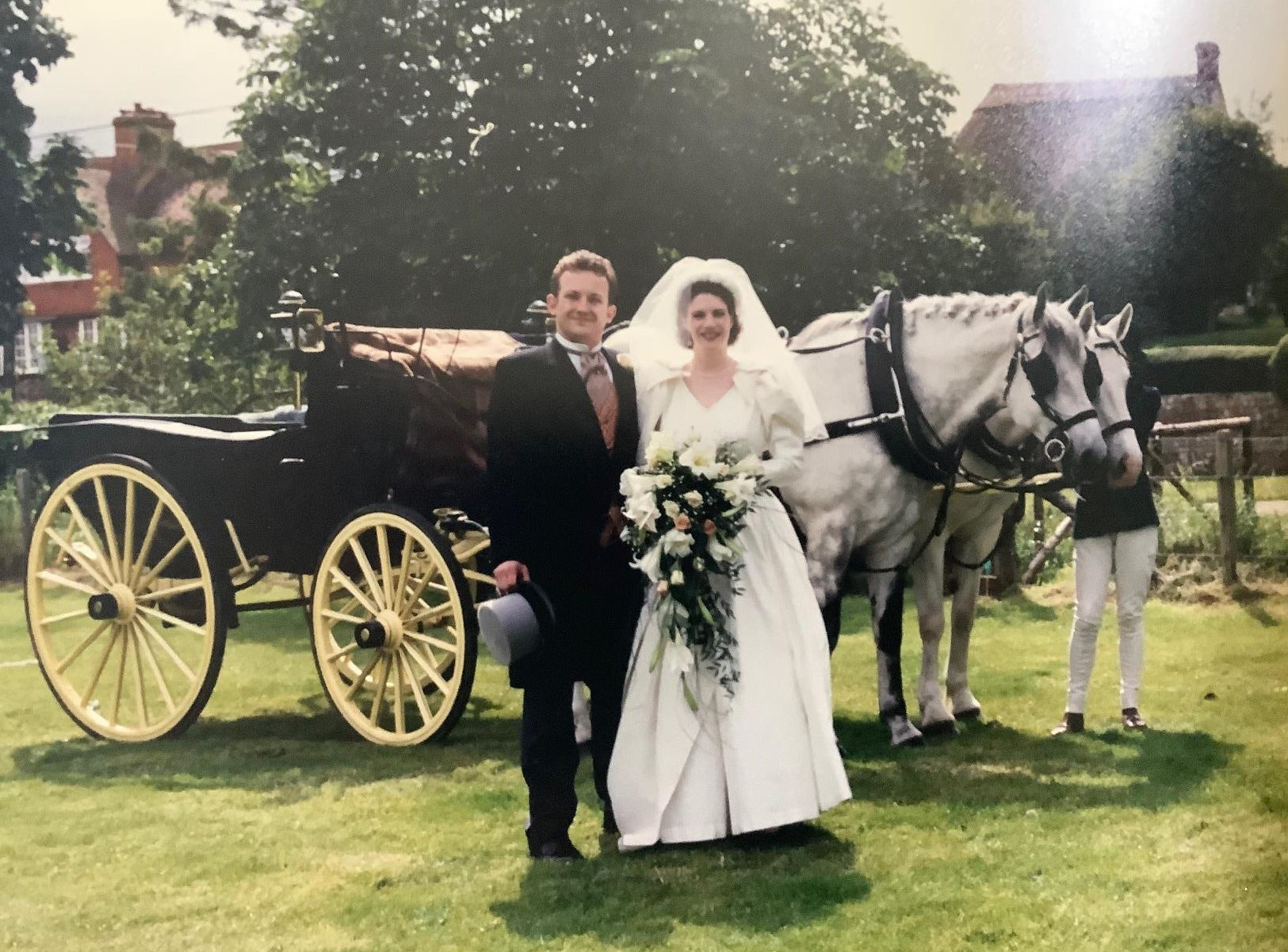
wedding trends in the 1990s
Regardless of the decade, every wedding photo is a time capsule for dresses (material, styles, length and colours) along with bouquets, veils and hair styles. They are an exaggerated example of fashion trends of their day and epitomise moments in time. Some decades certainly have common trends.
Famous faces that tied the know in the 90s included: Jada Pinkett and Will Smith, Cindy Crawford and Rande Gerber, Nicole Kidman and Tom Cruise, John Travolta and Kelly Preston, David Bowie and Iman, Michael Jackson and Lisa Marie Presley, and David and Victoria Beckham.
On 19 June 1999, Prince Edward (youngest son of Queen Elizabeth II) married to Sophie Rhys-Jones at St George’s Chapel, Windsor Castle making it the only royal wedding of the 90s but not a state occasion.
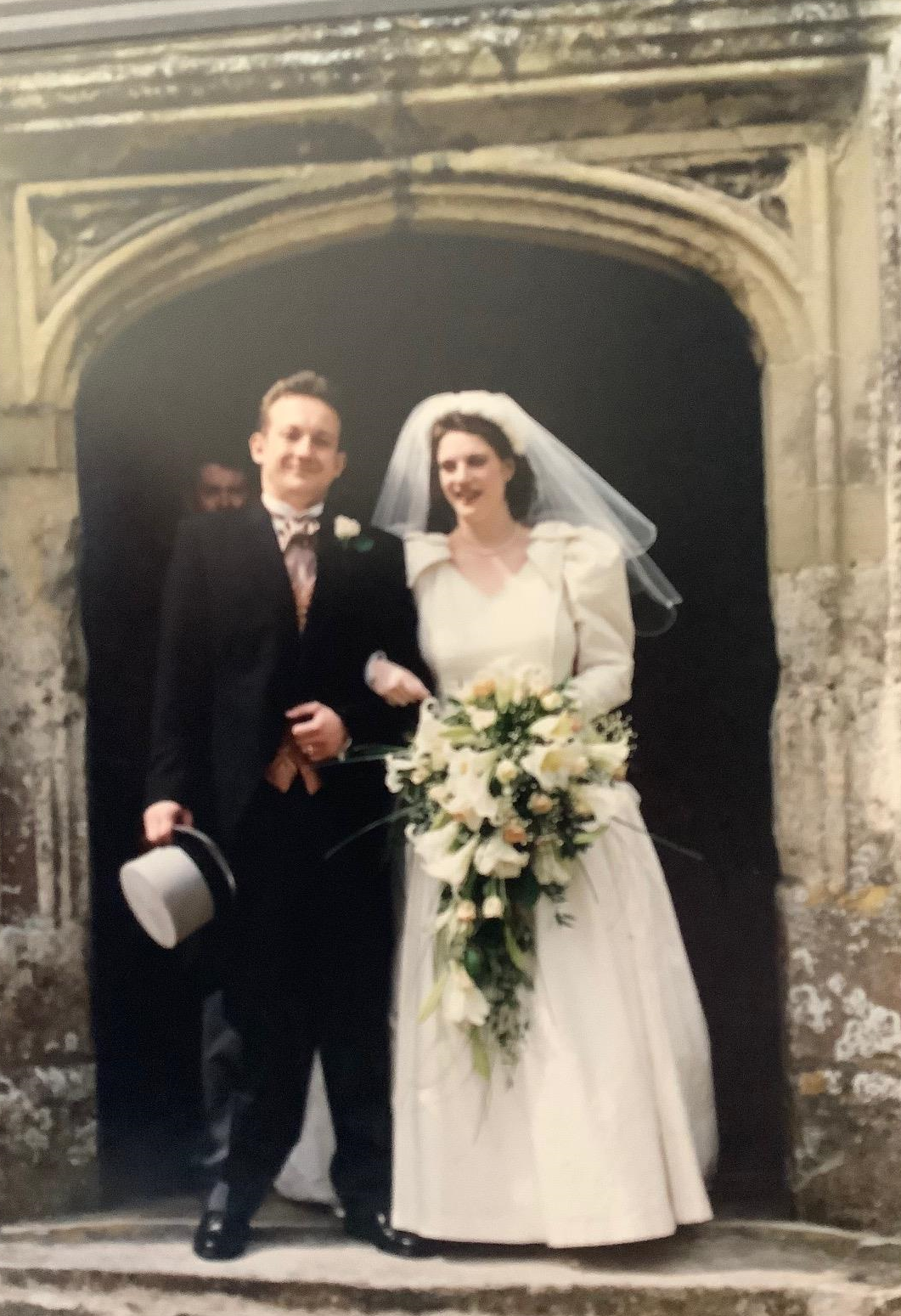
This is also the era that weddings venues could be local pubs, hotels and country houses as the Marriage Act of 1994 allowed legal marriages to take place in certain “approved premises”. (Before this amendment, marriage ceremonies could only be conducted in churches and register offices.) So now a countryside hotel was a typical location for the wedding reception and ceremony.
Couples were spending more on their wedding celebrations around 15 times the national weekly wage (of £340.18) with an average wedding costing around £5,000. The average cost of a wedding dress was £690 and was often a corseted off the shoulder dress with a full skirt and a coat or bolero in matching material (to cover up shoulders in church), or a bias cut, sheath dress.
Couples would invite around 80 guests, who would have disposable cameras on their tables to capture their own candid photos of the day.
If you got married in the 1990s then your starter was probably smoked salmon or soup, followed by a choice of chicken, beef or fish, whilst pudding was probably some sort of pavlova or cheesecake.
weddings in 1993
In 1993, there were 299,197 marriages in England and Wales (compared to 240,854 in 2013). There were 37.7 men marrying per 1,000 unmarried males and 38.1 females. The number of weddings has steadily declined over the years.
The average age of men getting married in 1993 was 29.2 and 27.2 for women (which continues to steadily rise).
49% of weddings took place in a religious ceremony in 1993 (which continued to decline further after the introduction of legal marriages in other approved premises).
real wedding from 1993
During lockdown, I reached out to local supplies to share their own weddings across different decades. I was delighted that Julie Lane, a hugely talented celebrant, shared her own special day in 1993.
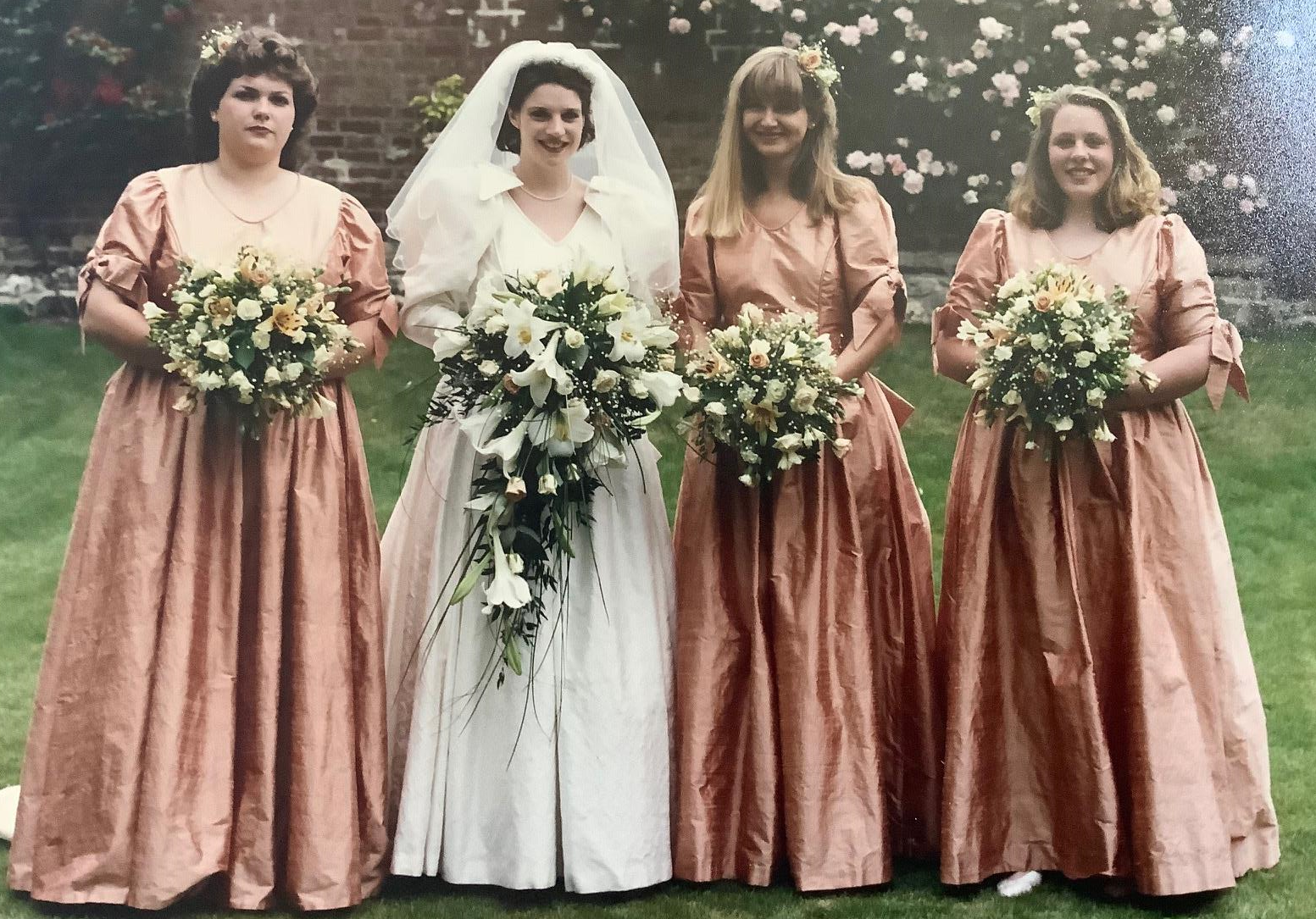
Julie and Andy got married on 19th June 1993. They chose that date because a friend of theirs had got married the year before on 13th June and the weather had been perfect.
The wedding was held at the village church where Julie was brought up in Stapleford, Wiltshire (bizarrely Andy was brought up in another Stapleford in Nottinghamshire.) They met in London where they both had moved to.
Peach was the colour for the bridesmaids’ dresses and the lining of the marquee, napkins etc. There were three bridesmaids – Andy’s sister, Julie’s cousin and a close friend. The men all wore top hats and tails with pin striped trousers. Lesley Shaw designed and made the wedding dress and the bridesmaid’s. She was based in Salisbury and the bridal dress was made in ivory silk duping. Andy had a waistcoat and cravate made to match the bridesmaids dresses.
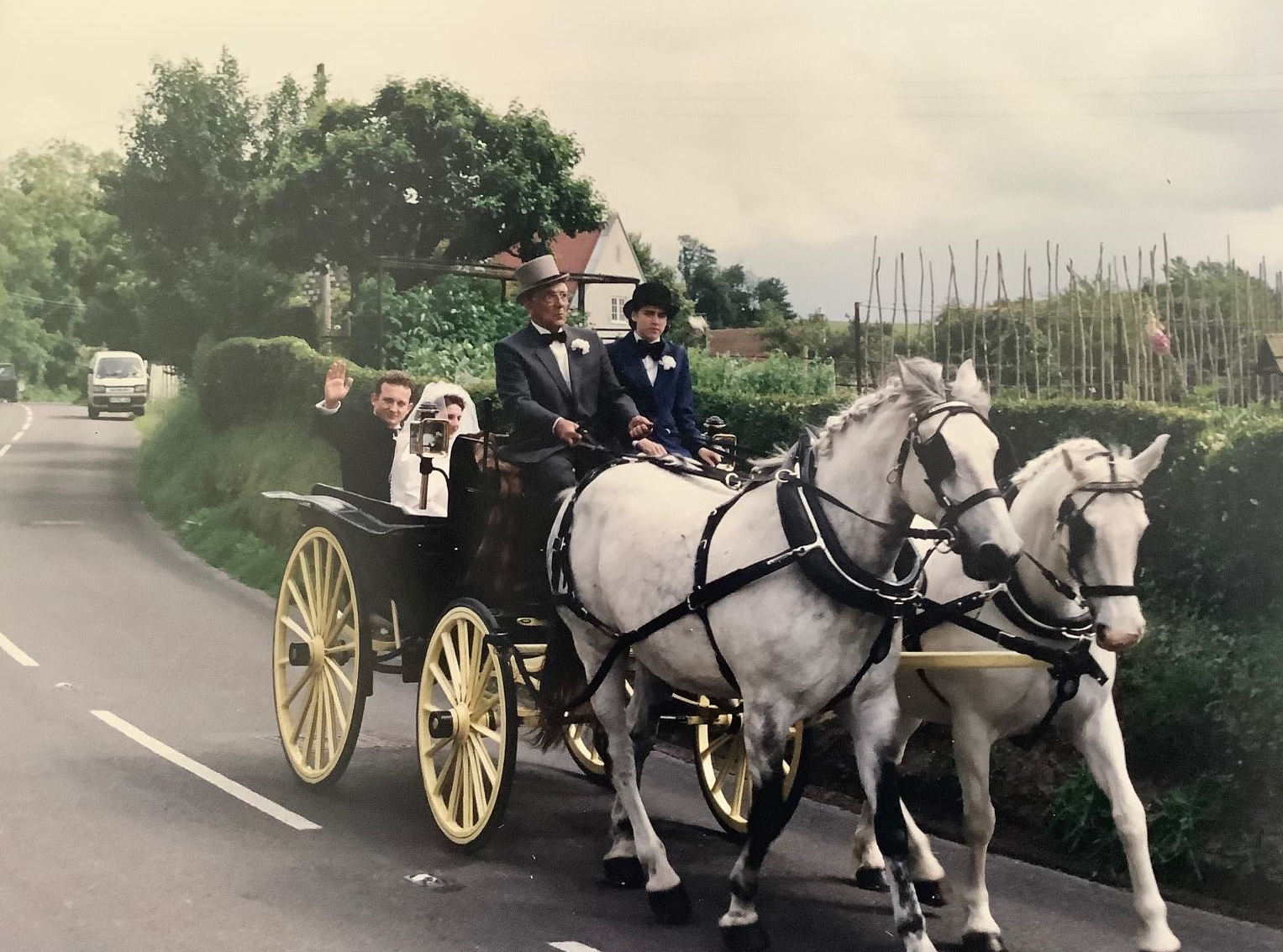
The transportation to the church was a complete surprise until the day of the wedding. The weather was a little uncertain so it was at the last minute that the bride’s dad took the roof off with his JCB so they had an open top horse drawn carriage. They trotted round from the bride’s parents’ farmhouse to the church, waving to onlookers en route to the church.
After the traditional church ceremony Andy and Julie rode in the carriage back to the reception. There was a jazz trio playing in the garden and Pimms was served whilst the families greeted the 153 guests (the maximum that the church could squeeze in).
There followed a wedding breakfast in a marquee in the orchard. A local caterer provided a simple delicious buffet with melon and Parma ham starters; Coronation chicken, poached salmon, new potatoes and salads for main; and strawberries and cream for dessert.
After the traditional speeches, they had the cutting of the cake. The timing was perfect – as the speeches finished, the evening guests began to arrive to make a total of 250 with a jazz band playing in the evening and a cheese and bread supper provided.
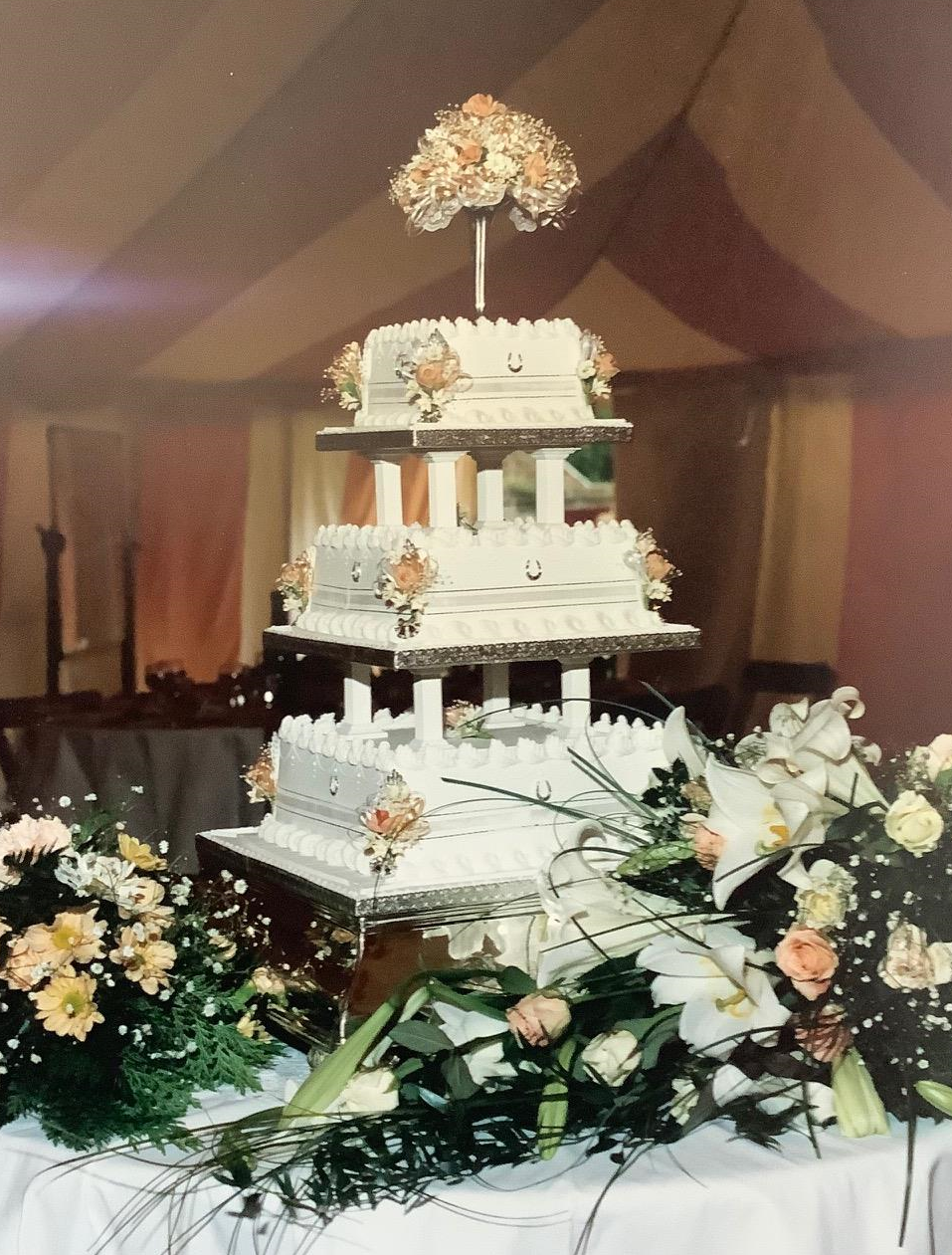
The happy couple stayed the night at a local hotel The Pembroke Arms, Wilton and spent the following day with guests (who had travelled and stayed overnight) with a barbecue. The following day they flew off on honeymoon to the Maldives.
about Julie Lane
Julie Lane has done quite a few weddings in Oxfordshire – Blenheim Palace, Eynsham Hall and The Perch, as well as Cripps Barn in Gloucestershire. After over 10 years as a Registrar, Julie became an Independent Celebrant and is relishing the freedom to help couples and families through those important milestones in their lives, including weddings, vow renewal, baby naming and funerals.
 @julielanecelebrant
@julielanecelebrant @juliecelebrant
@juliecelebrant @JulieLCelebrant
@JulieLCelebrant
summary
Weddings followed quite a cookie cutter approach in the 1990s but had a lot to live up to with big films like Four Weddings and a Funeral released. Thanks to this era, weddings could now take place in a variety of different types of venue opening up possibilities to couples.
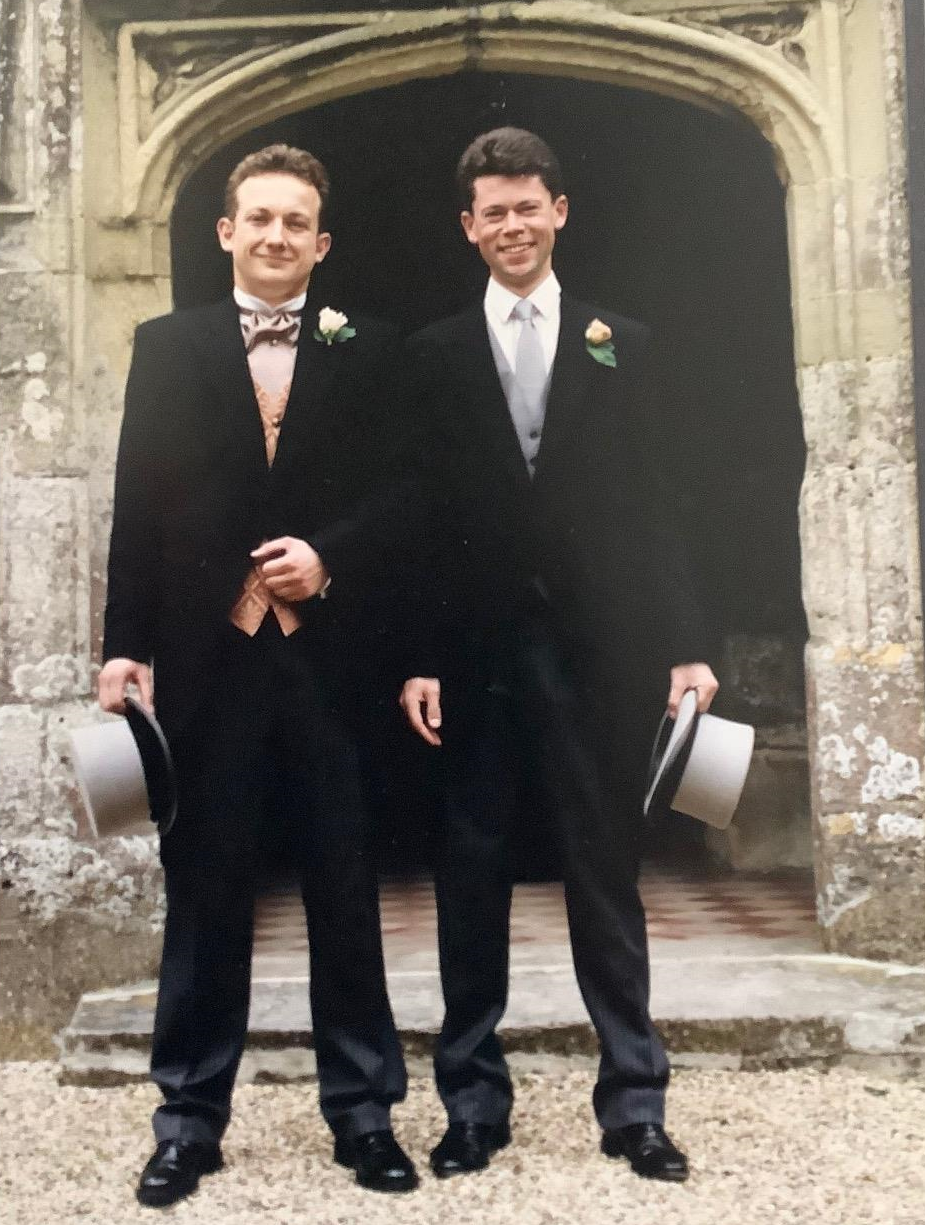
sign up to receive the latest posts straight to your inbox
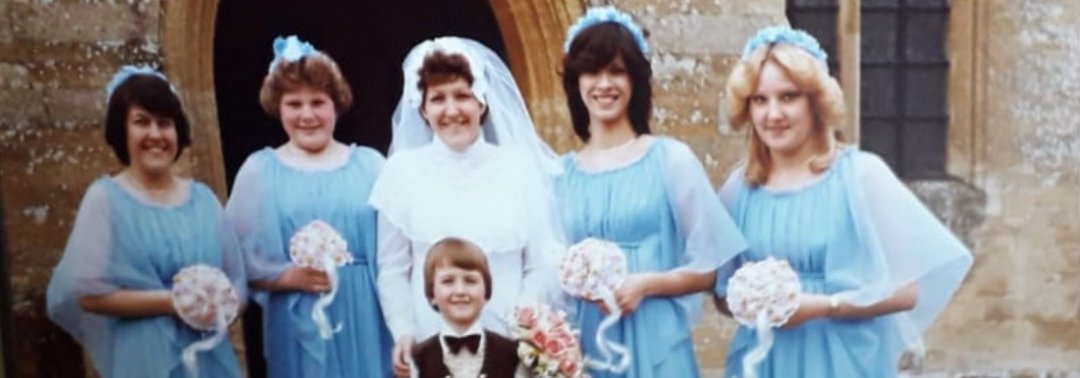
by Hanami Dream | 30, September, 2020 | blog, traditions
One of things that has been great about lockdown is the community camaraderie. No longer were our neighbours solely the people that we lived near by chance, but these became some of the only people that we saw for several months earlier this year. Spotting neighbours whilst out on your outdoor exercise for the day, or stood on our doorsteps for the weekly clapping for the NHS on a Thursday night. We all became more aware of our those that lived nearby because for once we were all around, all the time, at the same time.
We are really lucky that we live in a lovely cul-de-sac which already had a Ramsay Street quality about it – where everyone knows each other and there often is an annual street party (for some kind of royal occasion or national anniversary to observe) complete with street games, music and cakes.
The lockdown did make us all look out for the elderly and vulnerable more, we supported one another, shared and formed a neighbourhood What’s App group. For those of us who celebrated a birthday during lockdown, all the neighbours gathered (at a social distance) to sing happy birthday on the doorstep.
Whilst people have returned to work and are on the street less often, our neighbours now have names and we all know more about each other.
weddings through the decades
As well as several birthdays during lockdown, there were also a number of momentous wedding anniversaries marked down our road as well. In particular, one set of neighbours celebrated their 40th wedding anniversary and shared a snap shot of the day on the What’s App group. This spurred on my idea to look at real weddings throughout the decades to look at differences, similarities and things we can learn to help with wedding planning now.
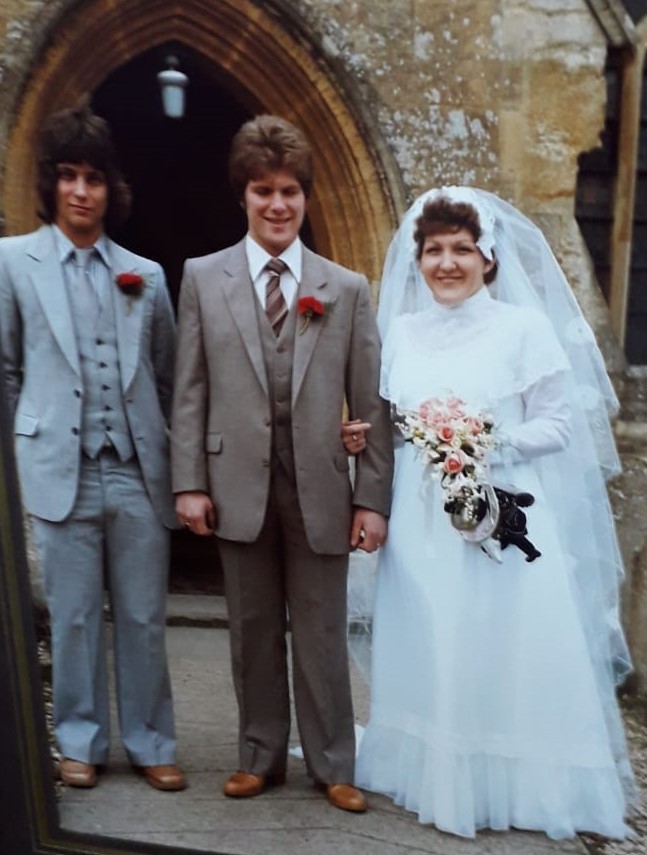
Britain in 1980
Not unlike this year, the country was facing recession in 1980 with rising unemployment (due to economic policies such as spending cuts and taxation rises) at a 45 year high of 2 million people (out of a population of just over 56 million in Britain back then). Plus there were steelworkers’ and miners strikes. And we were on the cusp of the Falklands war.
We had the first British female Prime Minster in the shape of The Iron Lady, Margaret Thatcher, who famously said that ‘The lady’s not for turning’ regarding her strong policies. Despite or because of her stance, the 1980s was a revolutionary decade which has shaped the way we live for ever.
highlights of 1980
Gone were the thifty days of the 70s, as people now had credit cards to borrow and flash their cash on fast food, exotic holidays, over the top clothes and shiny new computers.
Six out of ten British women were going out to work (higher than almost every European country) and it saw the rise of the yuppies (young urban professionals) with their chunky mobile phones, filo faxes and red braces.
Also in 1980, Alton Towers opened, the pre decimal sixpence coin was withdrawn from circulation (and is now only sported in brides’ shoes on their wedding day) and John Lennon was shot.
inventions of the 1980s
For me the 1980s was about Back To The Future movies, ET, Star Wars, Rubiks’ Cube, Sylvanian Families, dancing flowers, McDonalds, cassettes (I didn’t make it on to CDs yet), synthesizers, music videos and BMX bikes.
Music was typified by the New Romantics or pop factory soap stars like Jason and Kylie, along with Michael Jackson and Band Aid. We only just had 4 tv channels and front seat belts were only compulsory in 1983.
The biggest technological changes in the eighties were the introduction of home computers and by the end of the decade the world wide web, plus digital mobile phones (although these were very large and very expensive), microwave ovens and the first electric vehicle was invented in the 80s.
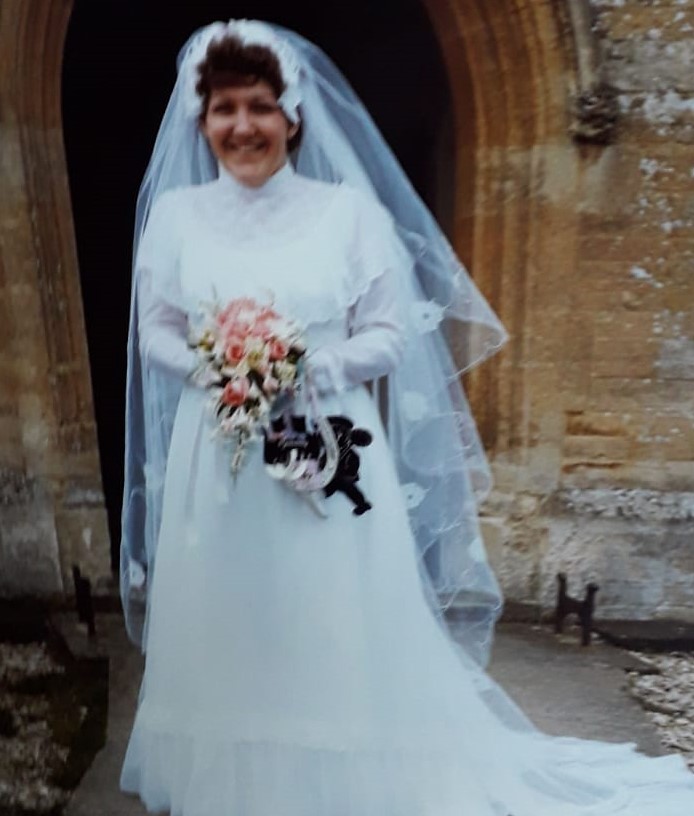
wedding trends in the 1980s
Regardless of the decade, every wedding photo is a time capsule for dresses (material, styles, length and colours) along with bouquets, veils and hair styles. They are an exaggerated example of fashion trends of their day and epitomise moments in time. Some decades certainly have common trends.
Wedding of the 1980s can be summed up by the royal weddings of Prince Charles and Diana (30 July 1981) and Prince Andrew and Sarah Ferguson (23 July 1986). And the much anticipated Neighbours wedding of Scott and Charlene, plus The Princess Bride movie. Think of these and you’ve got over the top, puff sleeves (which are back in trend now), frills, lace, big tiers of wedding cake and the start of videography to capture the day.
These weddings showed that more is definitely more. After a church service, the reception would be held in a hotel with a disco and lots of dancing. Typical food could have included prawn cocktail for starters, a chicken main, followed by a black forest gateaux for dessert.
Couples were beginning to spend more on their wedding celebrations – around 7 times the national weekly wage (of £145.88) with an average wedding costing around £1,150 and they started to invite more guests.
weddings in 1980
In 1980, there were 370,022 marriages in England and Wales (compared to 245,513 in 2015). There were 60.4 men marrying per 1,000 unmarried males and 48.1 females. The number of weddings has steadily declined over the years.
The average age of men getting married in 1980 was 29.4 and 26.7 for women (which continues to rise).
50% of weddings took place in a religious ceremony in 1980 (which continues to decline).
real wedding from 1980
My neighbours, Karen and Paul, married on Saturday 26th April 1980, 40 years ago. Their ceremony was held at 3pm at St Martin’s Church in Bladon, followed by a reception at Long Hanborough Pavilion.
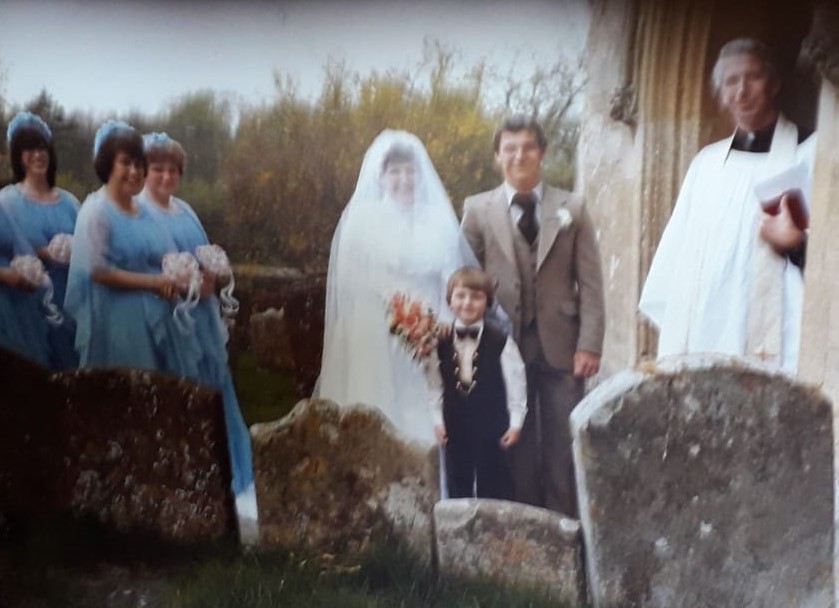
They travelled in a brown Ford Cortina. The bridesmaids had a pale baby blue and white colour theme.
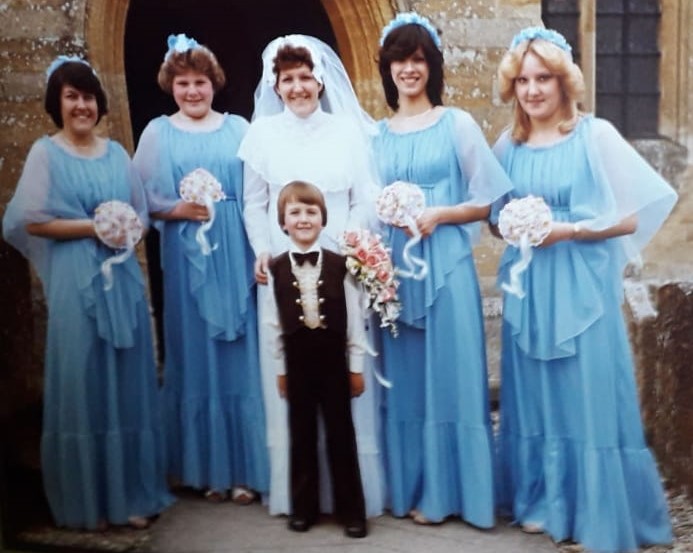
The food served at the reception was a cold sit down meal, and a buffet in the evening. During the afternoon there was soft background music and then a disco in the evening.
And they went to a hotel afterwards which was a surprise present from the best man.
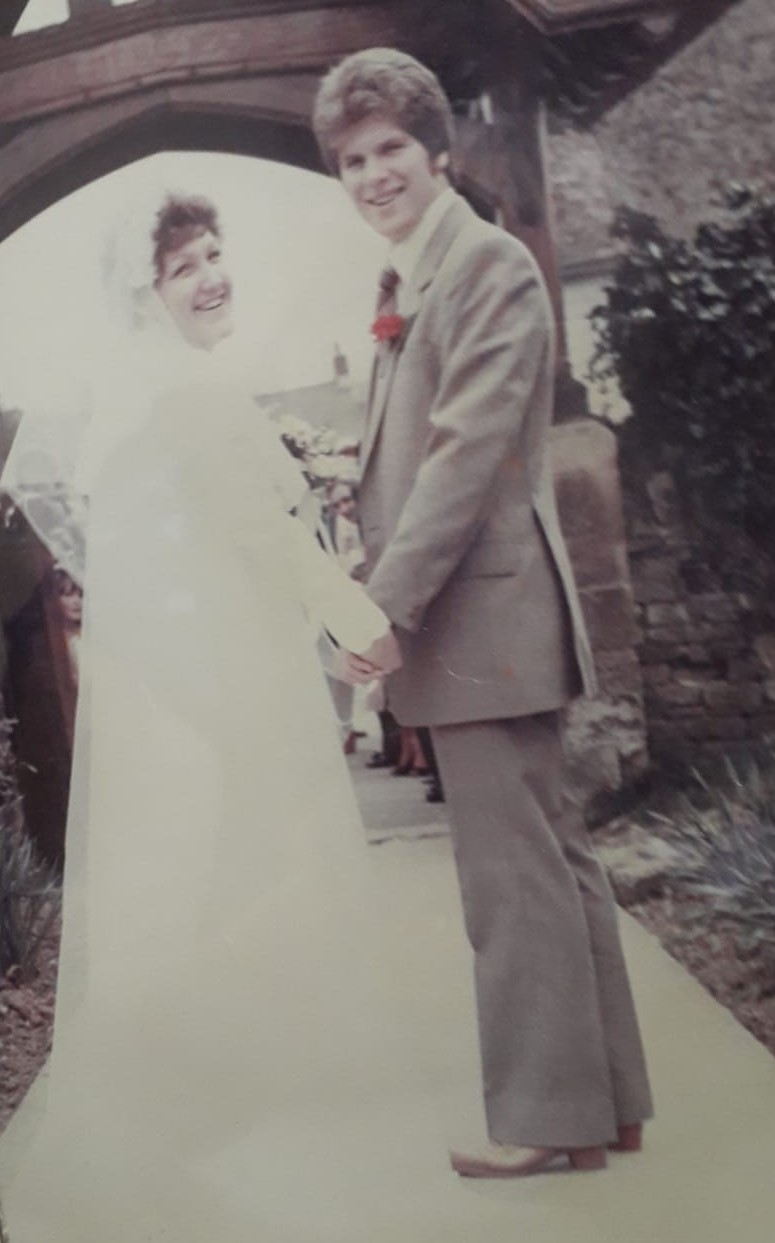
summary
Big may have been better in the 1980s (even if couples had to borrow to achieve it) but we owe a lot to that decade – imagine planning a wedding now without the internet on your phone or computer!
sign up to receive the latest posts straight to your inbox
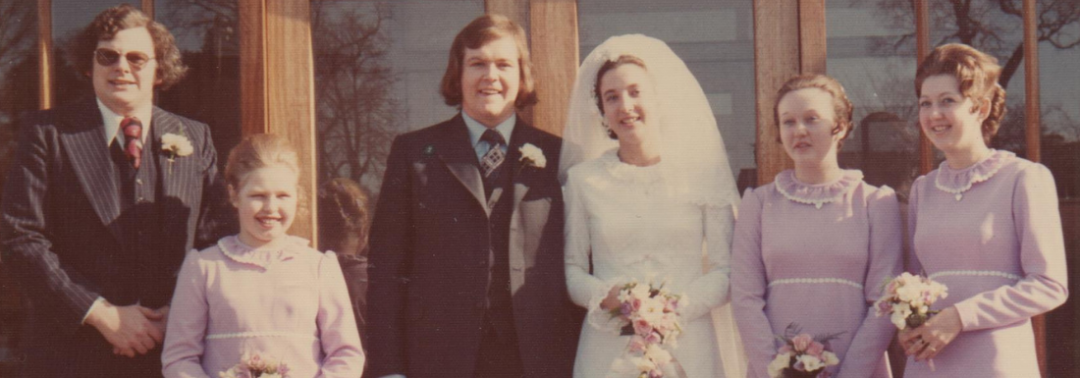
by Hanami Dream | 10, July, 2020 | blog, traditions
The current guidelines for weddings are making couples re-evaluate what is important to them for their wedding. In some ways, it is stripping the wedding back to just the ceremony and the legality about becoming married. It has actually made me consider whether there is maybe too many extra frills added to weddings in this day and age. Are couples putting too much Instagram-ready stress and Pinterest-perfect pressure (both physically and financially) on themselves to have the ‘dream’ wedding day? Maybe stripping back the wedding will bring things back to basics and focus on what really matters.
weddings through the decades
During lock down I’ve felt quite reminiscent. It has certainly been a time to look back and reflect. So whilst weddings are going through a transformation, I am taking a look at some real weddings over the decades to see if there are some things that we can take inspiration from and use to help with wedding planning in the future.
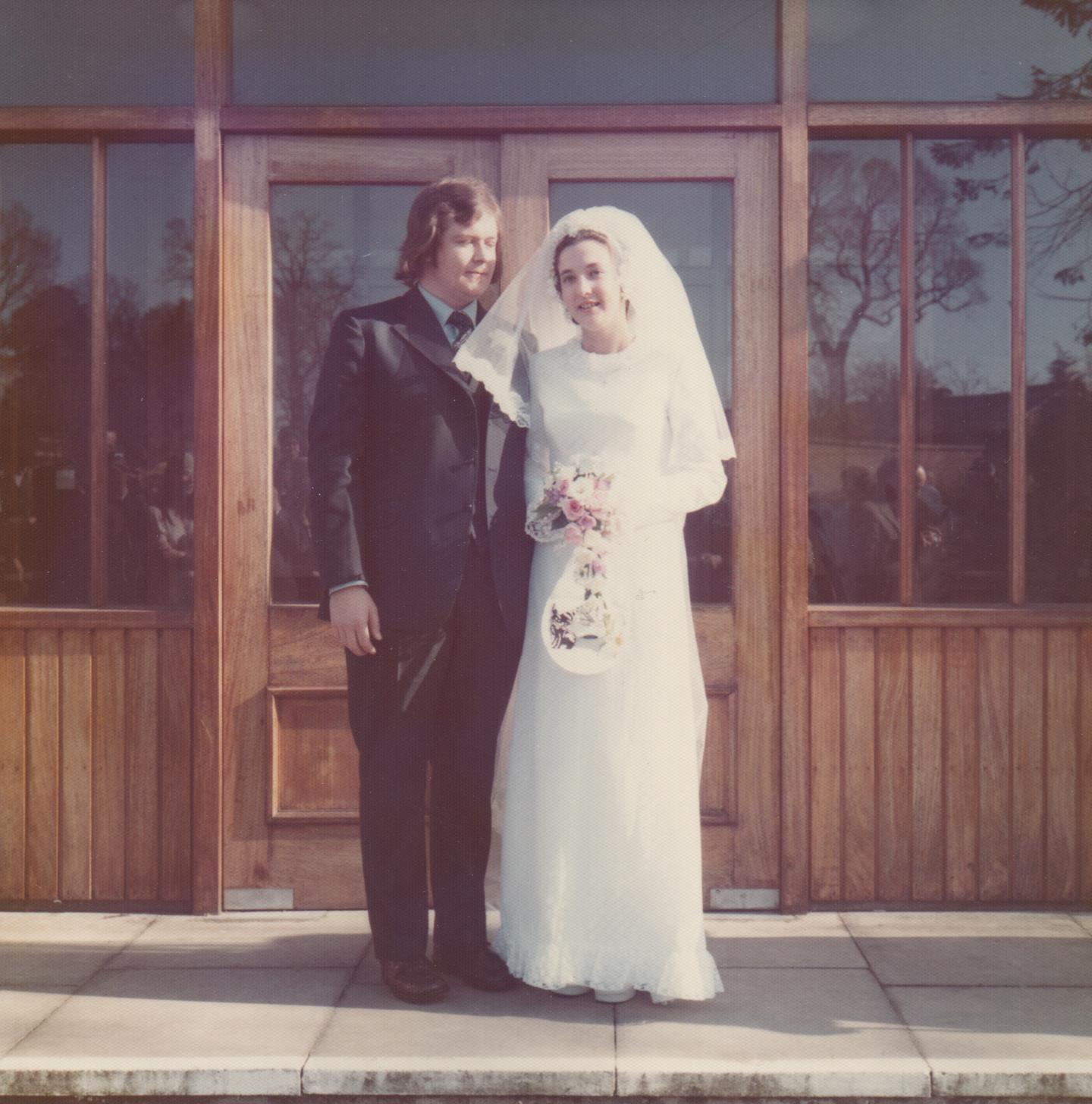
Rewind over 40 years ago to my parents wedding in 1974 and it wasn’t the norm to have a big wedding reception. The ceremony was the main event. There’s more than a few other similarities between then and now to take note of too:
Britain in 1974
Seems like times were tough in 1974 too, in some ways like what we are facing this year. Britain was in its first post-war recession; they faced months of the Three-Day Week; two general elections and major government reorganisation; a state of emergency in Northern Ireland; many IRA bombings; lots of large companies struggling; plus oil shortages.
My Mum often speaks about the fact that during the 3 day weeks they were finally allowed to wear trousers to work as it was so cold when this ran between January to March. These measures were introduced to conserve electricity, due to the oil crisis and industrial action by coal miners. Aside from key services, people were limited to three days in a row of consumption each week and were not allowed to work longer hours on those days. TV stopped broadcasting at 10.30pm to conserve electricity. It was finally lifted on 7 March 1974.
In addition, new speed limits were brought in to help to curb fuel usage.
Bombings in Britain included the Houses of Parliament, the Tower of London, Birmingham pubs, M62 coach, and even the former prime minister’s London home. It was scary and uncertain times.
When my parents got married, Harold Wilson had just taken over as Prime Minister on 4 March, a labour leader of a minority government, from Edward Heath (Conservative). There was another election again later in the year. It was a time of huge change and turmoil.
highlights of 1974
Meanwhile, excitedly the Eurovision song contest was held in Brighton in 1974, the one when Abba won with the song ‘Waterloo’. Liverpool won the FA Cup adding to their trophy cabinet, a bit like this year.
Ceefax started, though I wonder how many people planned their wedding or booked a honeymoon using this sure predecessor to the internet. And McDonalds opened their first restaurant in Woolwich.
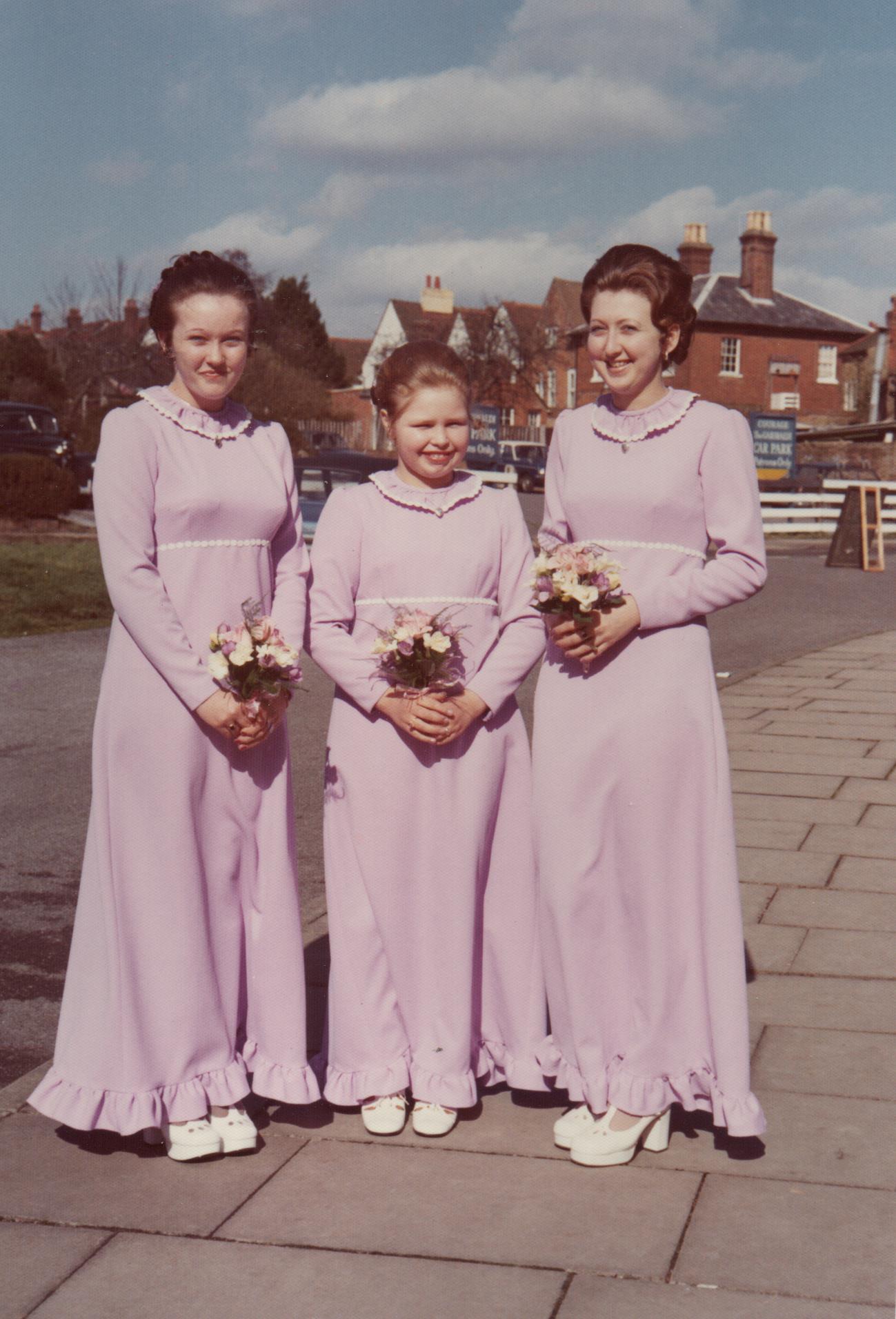
Princess Anne’s first wedding
Whilst a dramatic kidnap attempt on Princess Anne was the focus in 1974, her wedding at the end of the previous year had brought royal wedding fever to the country, albeit a bit more subdued compared to more recent ones. The wedding of Princess Anne and Mark Phillips took place at Westminster Abbey in London in November 1973. She wore a high necked, high-waisted, embroidered Tudor-style wedding dress, with a high collar and medieval-influenced sleeves. Anne had her trade marked beehive up-do.
I’m not sure that Anne’s wedding had the same impact as the modern royal weddings of William or Harry. However, she was the first of the Queen’s children to wed and the event was televised. Much of my parent’s wedding had been already organised by the time of Anne’s but there are still some influences in hair and dress styles that can been seen.
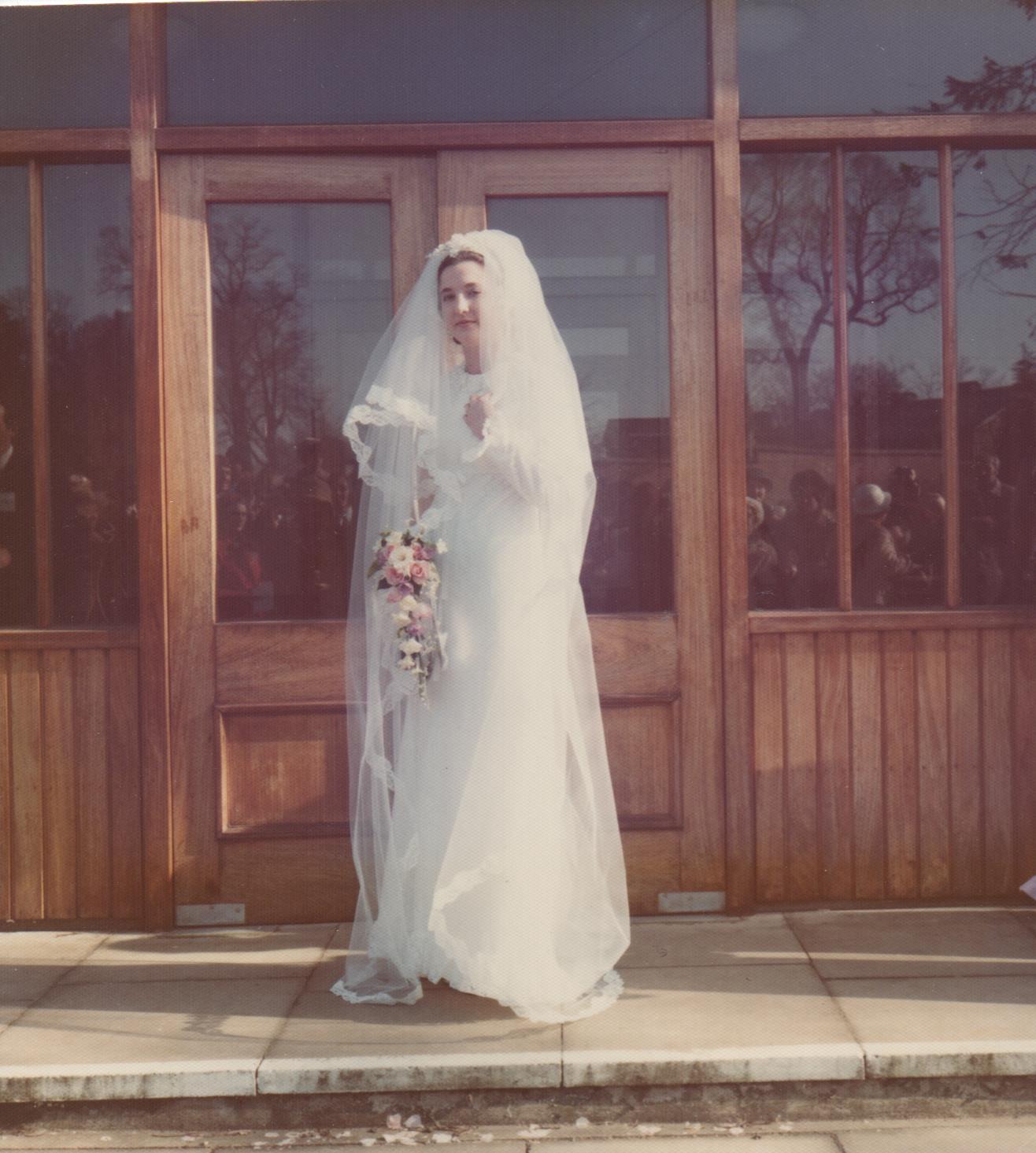
wedding trends in the 1970s
Regardless of the decade, every wedding photo is a time capsule for dresses (material, styles, length and colours) along with bouquets, veils and hair styles. They are an exaggerated example of fashion trends of their day and epitomise moments in time.
Some decades certainly have common trends. In the 1970s, this could be seen with two distinct looks: hippy style, long sleeved, high necked, longer length dresses. Or trouser suits with big floppy hats. First and foremost, the bridesmaids never outshone the bride.
Weddings were intimate and not frivolous or extravagant, often with the reception held down the pub. Typical food could have included prawn cocktail, fondue, vol au vents, pineapple and cheese on sticks, chicken kiev, or steak Diane and chips if you were splashing out. With arctic roll or black forest gateaux for dessert.
But money was tight, with an average weekly wage of only £34.64. Families helped couples pay for their big day and a wedding in the 1970s cost just £1,850 on average. (Compared with an average spend now around £27,000 on a wedding before lockdown).
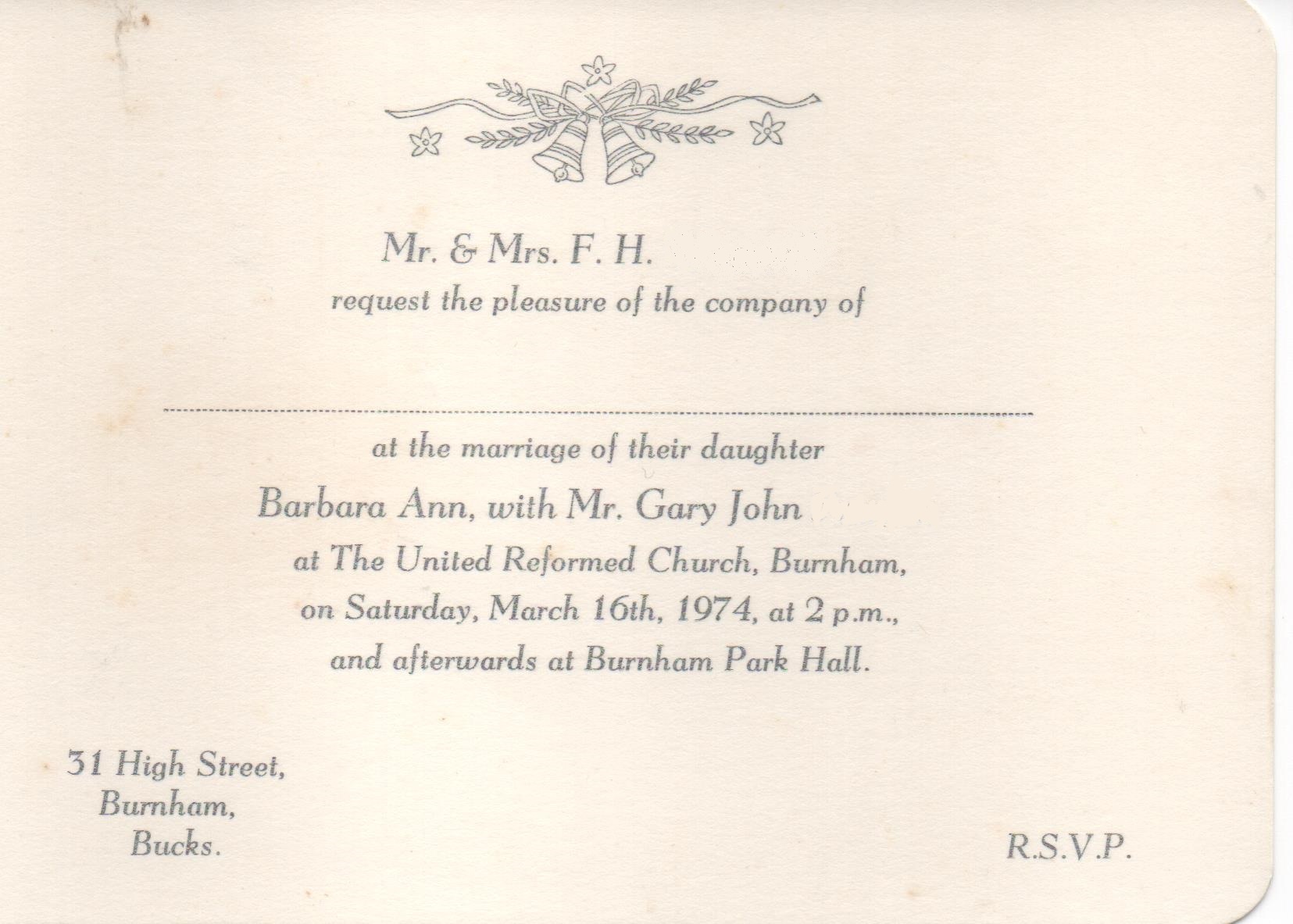
weddings in 1974
In 1974, there were 384,389 marriages in England and Wales (compared to 40 years later of 252,222 in 2014). In 1974, there were 69 men marrying per 1,000 unmarried males and 53.7 females, compared to 23.0 and 20.9 in 2014. The number of weddings has steadily declined over the years.
The average age of men getting married in 1974 was 28.8 and 26.2 for women (compared to 37.0 and 34.6 respectively in 2014).
53% of weddings took place in a religious ceremony in 1974 versus 27% in 2014.
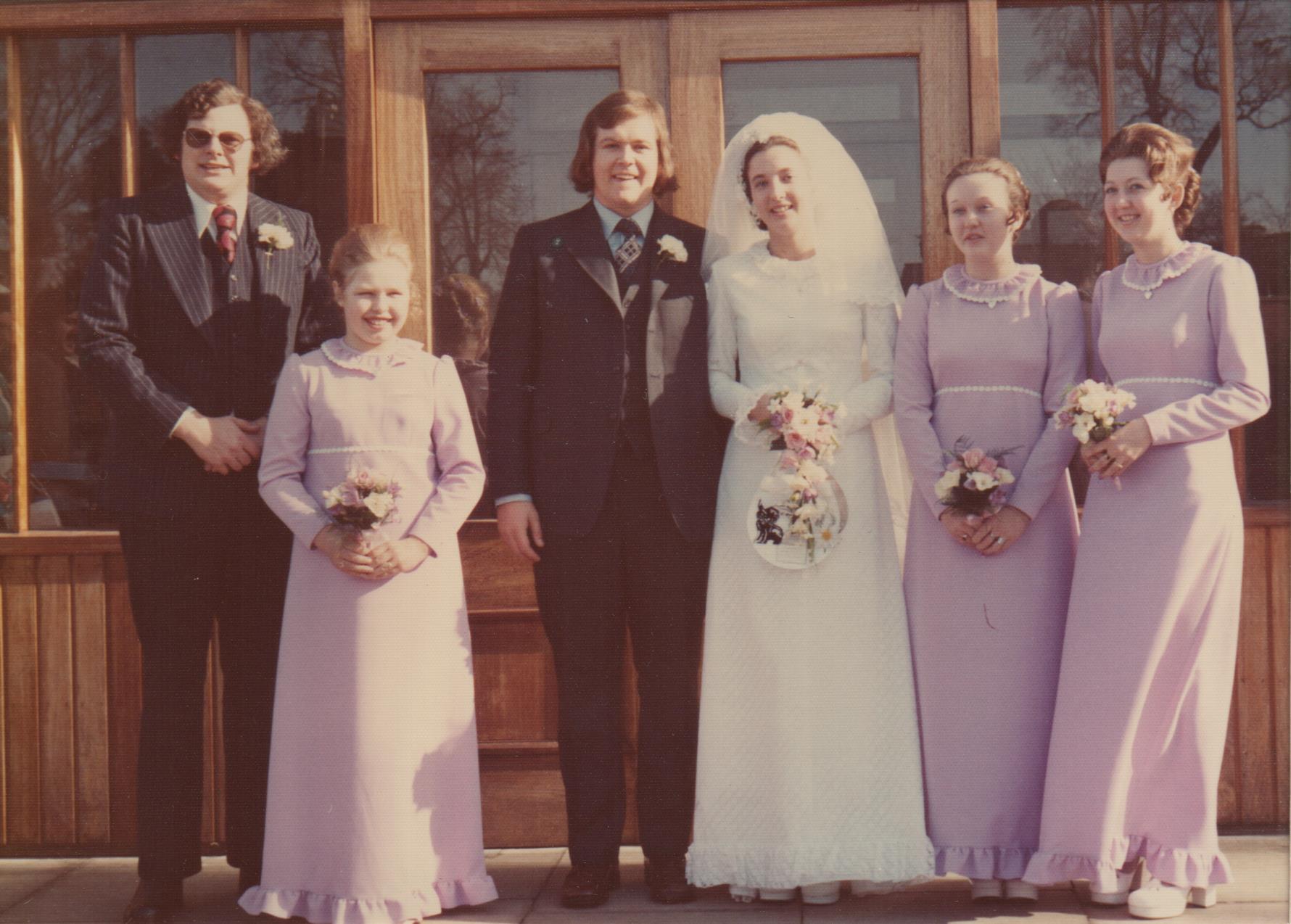
real wedding from 1974
My parents, Barbara and Gary, married on Saturday 16th March 1974, over 46 years ago.
To quote my mother, weddings were not so ‘flashy’ back then, without extras ‘like today’. There wasn’t any money then – they didn’t have any and neither did their parents. The groom even had to borrow money from his father in order to buy the engagement ring.
Weddings were very traditional, almost following a formula or cookie cutter approach.
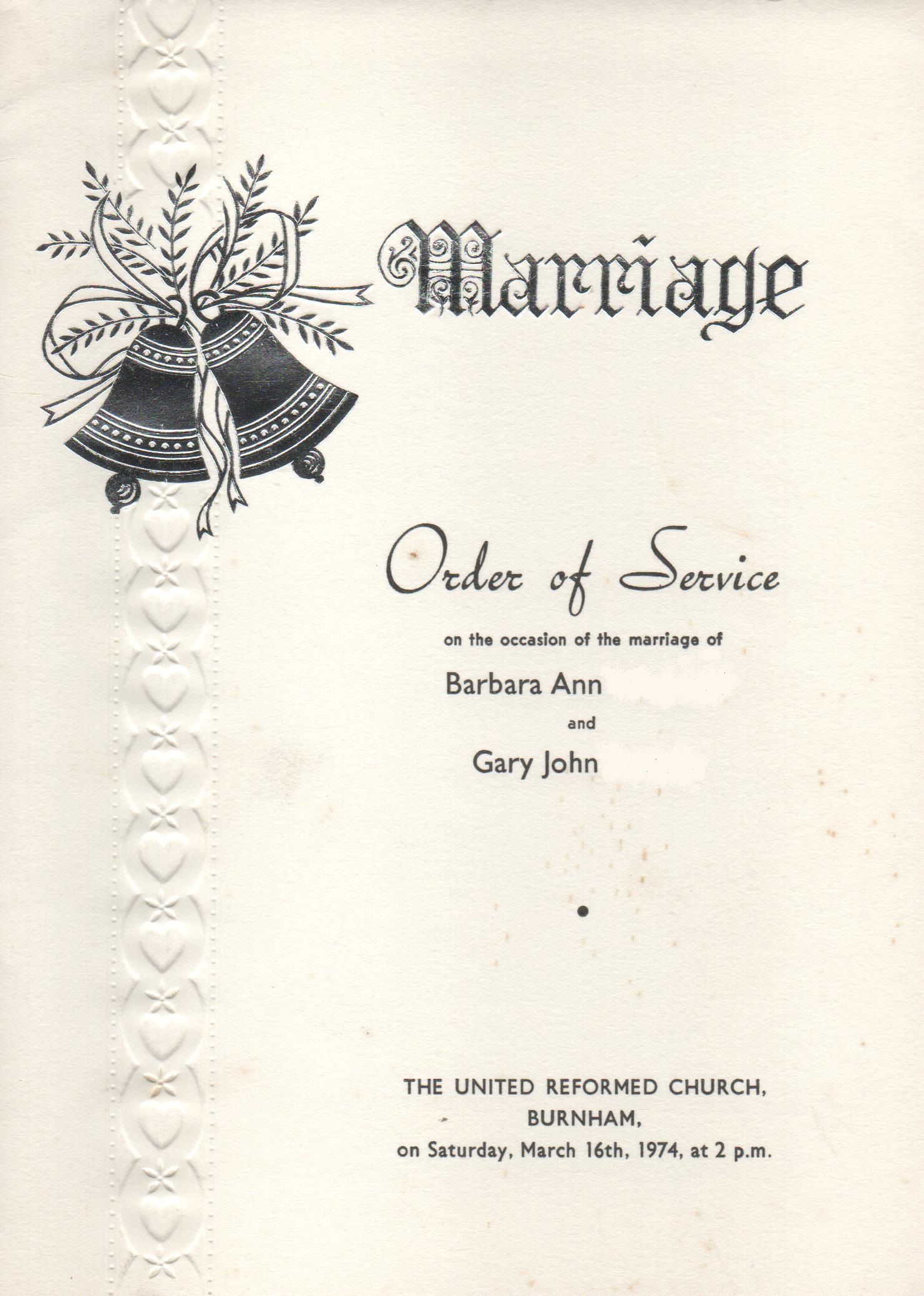
formal invitations
My parent’s wedding invitations were very formal and sent from the bride’s parents. They were simple, classic and from a stock suite including silver embossed bells. The same style was used for the Order of Service too.
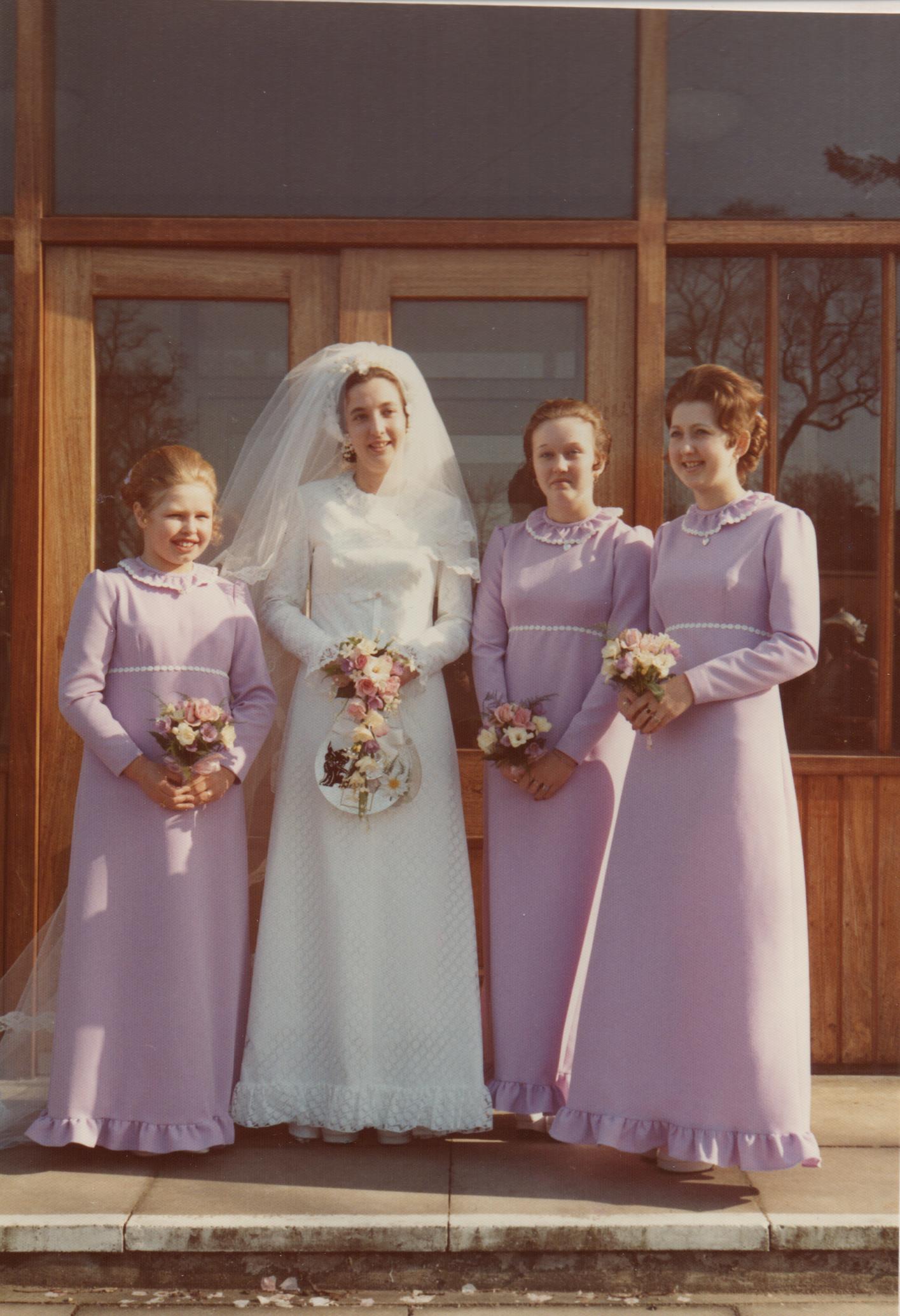
full length attire
The bride wore a Pronuptia A line dress with high neck and long sleeves and a long veil, along with some white platform shoes. She carried a bouquet of freesias (her favourite flower) and roses.
Whilst there wasn’t a specific colour scheme or theme that went throughout the wedding, the 3 bridesmaids all wore lilac coloured dresses (which was a copy of the bride’s dress) that matched the flowers. They all had their hair the same – up like Princess Anne – and the bridesmaids had lilac flowers in their hair.
Meanwhile the groom and best man just wore their own best suits and wore carnations as buttonholes.
The bride was driven in a car hired from a local firm, whilst the bridesmaids were just driven by a friend of the family in his own car.
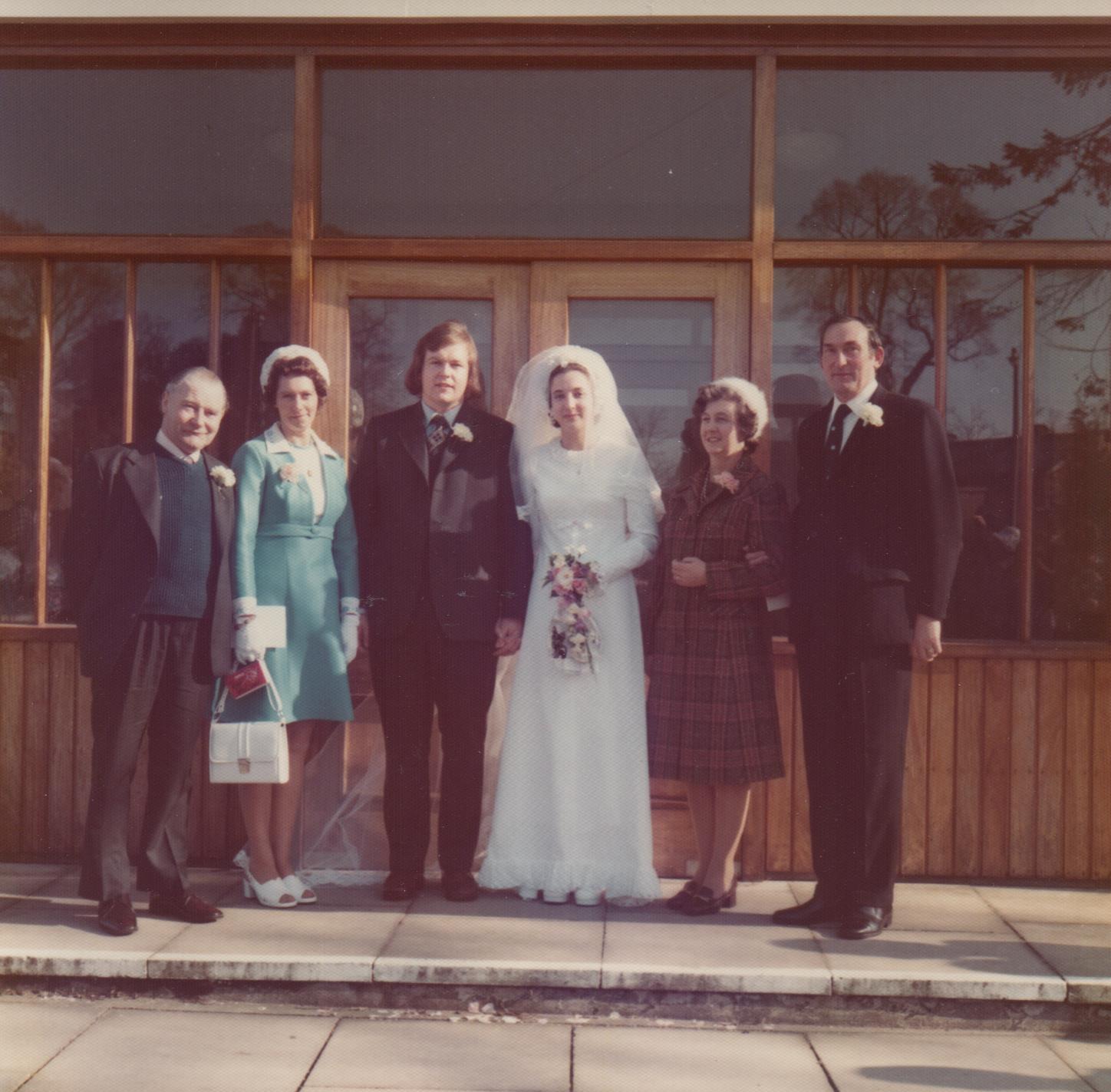
local ceremony and reception
As with the majority of weddings in the 1970s, they had a church service at Burnham United Reformed Church starting at 2pm. Afterwards, they had their reception at a simple village hall, Burnham Park Hall, that cost them £8.80 to hire the hall and kitchen from 10.30am – 6pm. After the meal, the speeches followed the usual order and focused on the father of bride, best man, plus the groom.
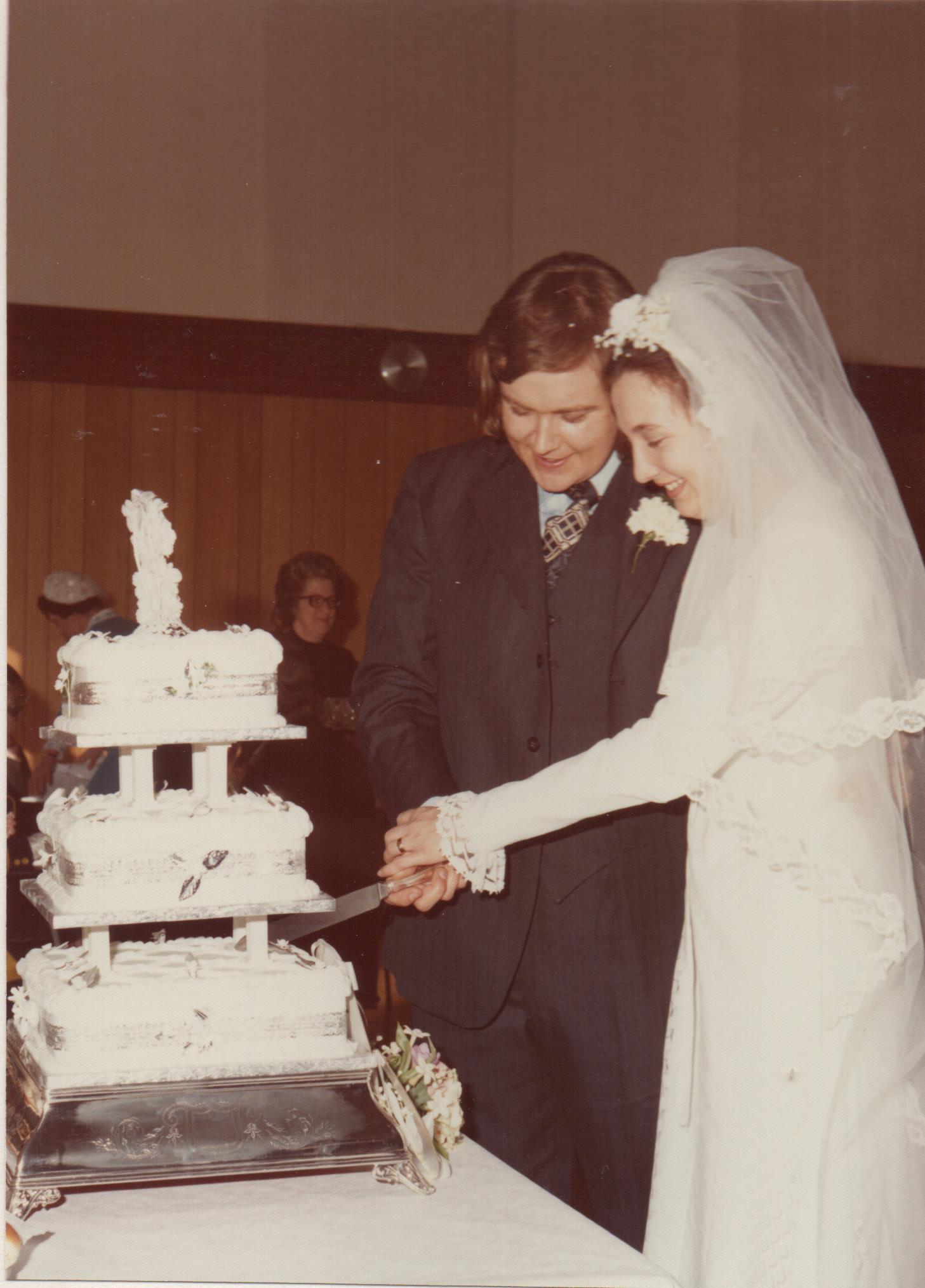
minimal decor
They didn’t decorate the hall. There were only tables with white tablecloths on them. But the curtain material in the background of photographs gives away the era completely. It would have been hard to compliment them with many colour schemes!
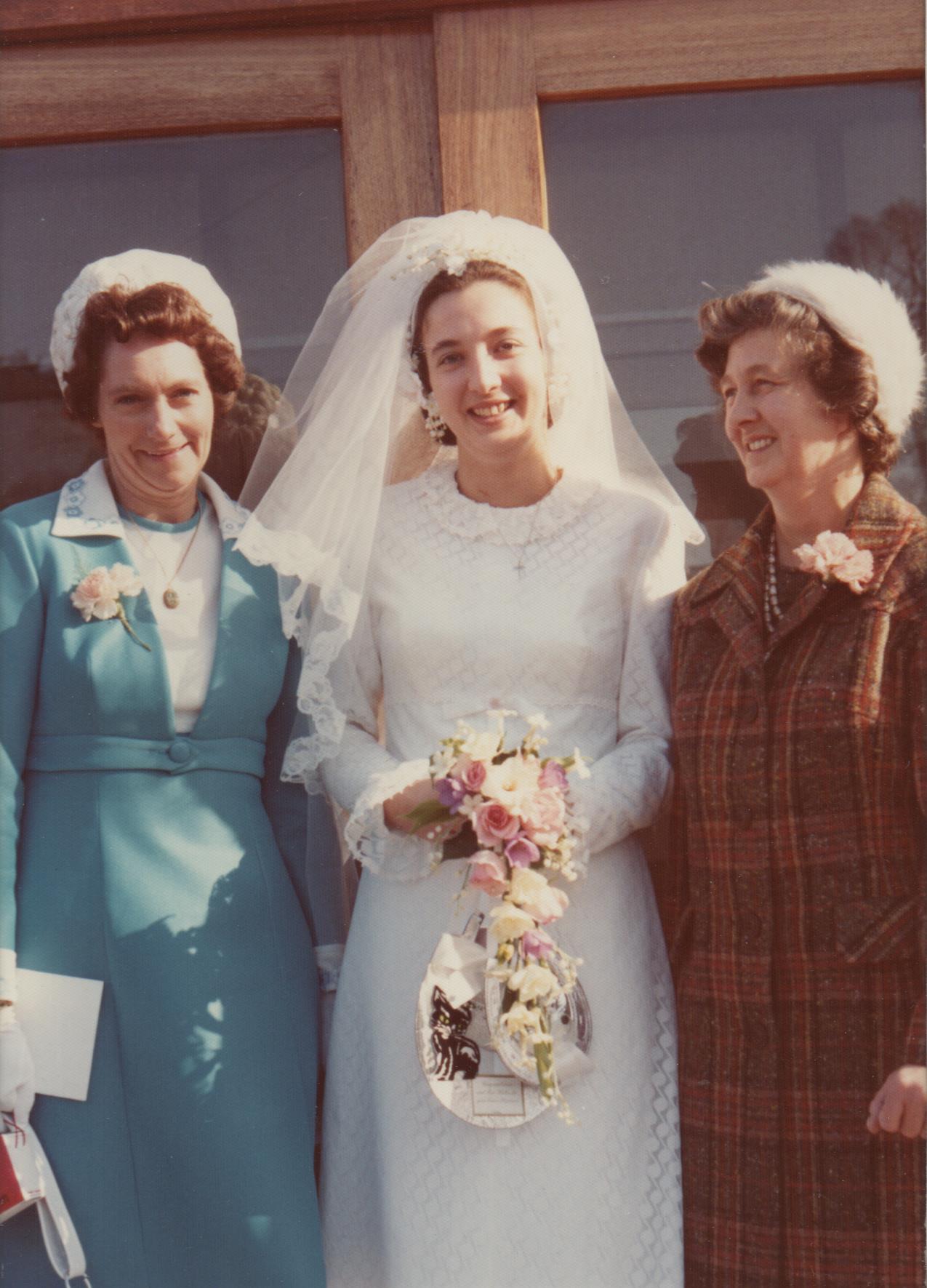
cost efficient food
The guests ate a buffet by The Barn Restaurant, Salt Hill Park, Slough. It may have been a beige buffet typical of the time although it obviously wasn’t too memorable as my mother isn’t sure what they picked. The accountant in her can remember that the prices started at a mere £0.85 per person. And their drinks bill cost £29.61.
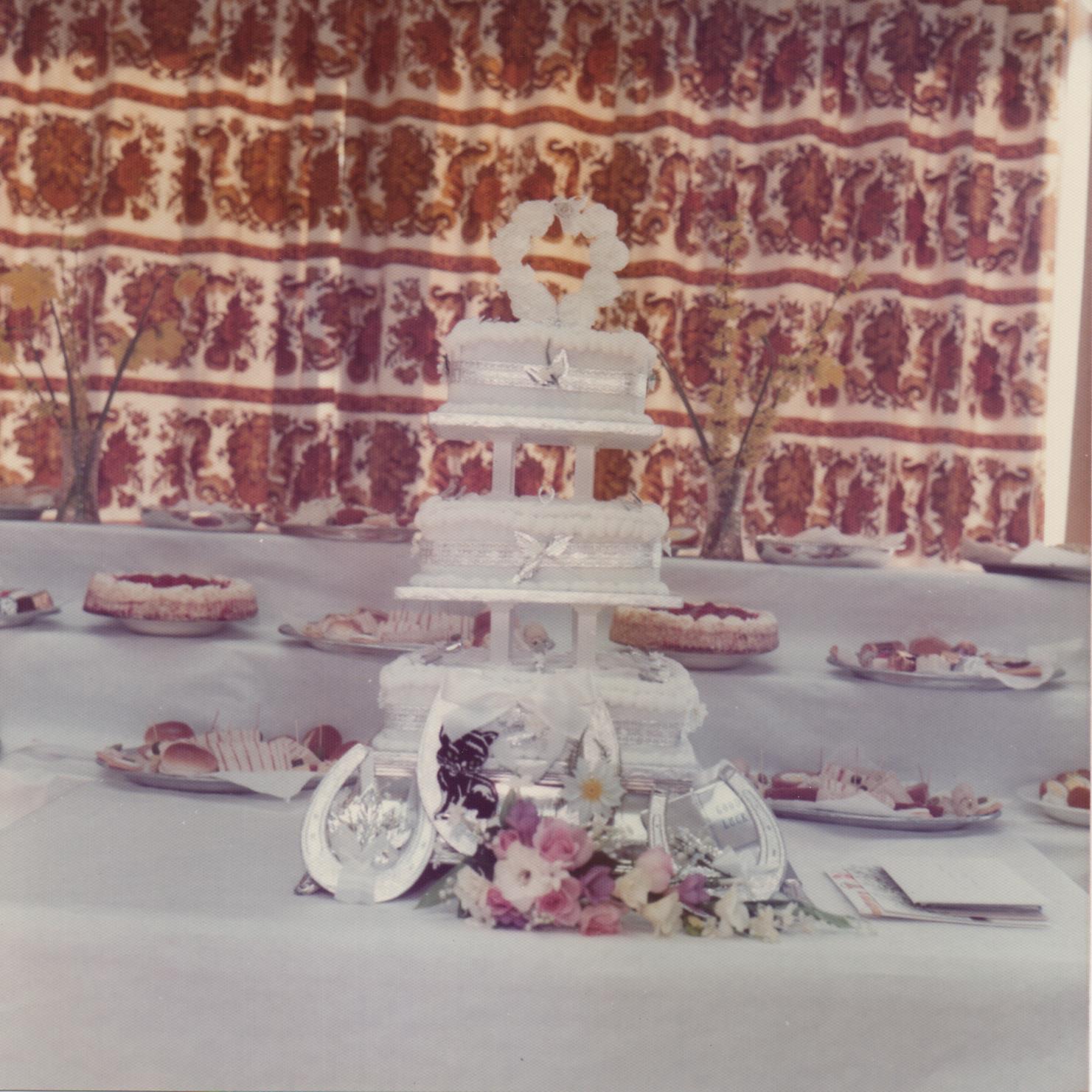
traditional cake
The wedding cake was an incredibly traditional square 3 tier fruit cake made by a family friend. There weren’t any added extras like favours at the wedding.
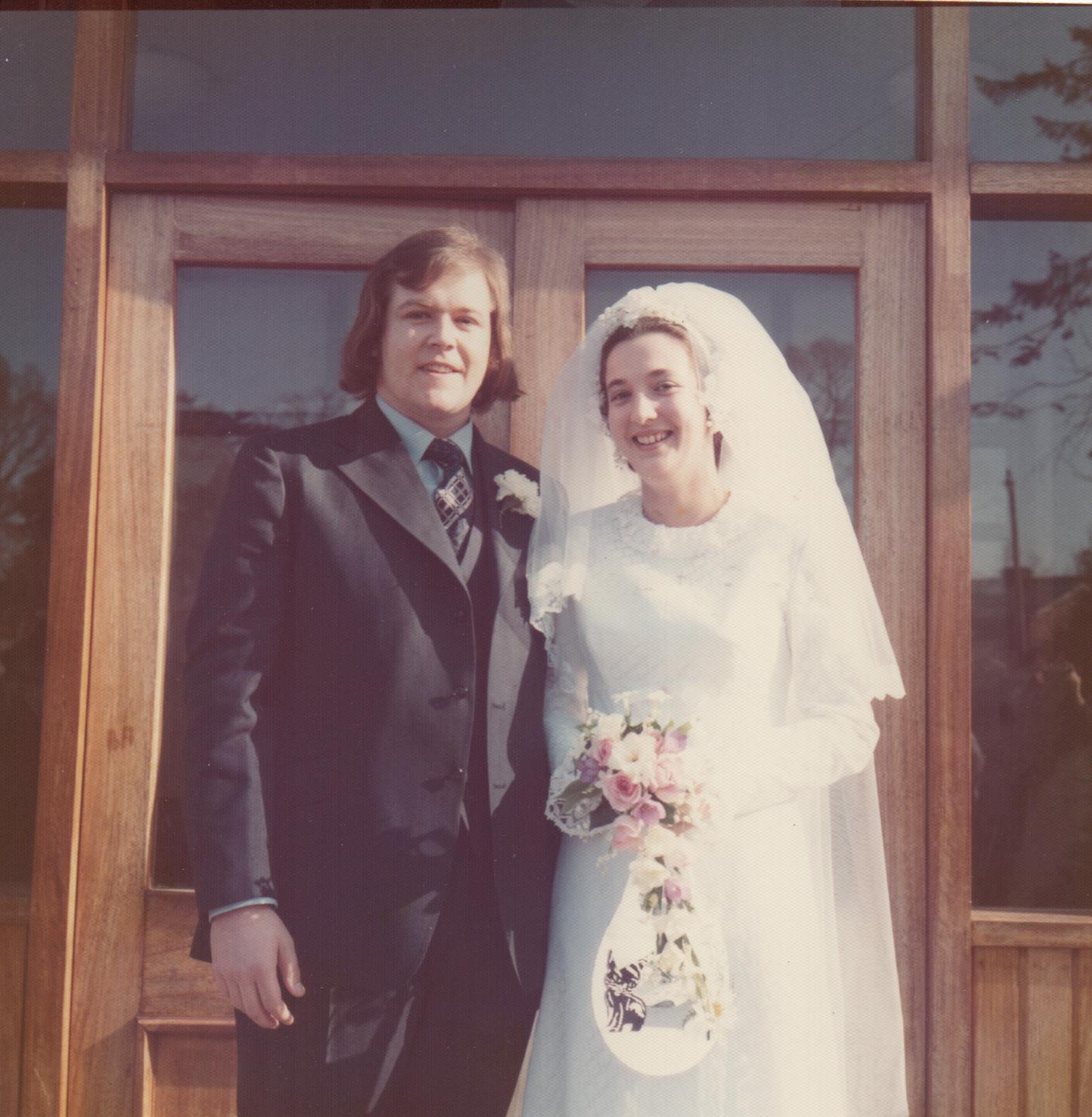
shared entertainment
My parents didn’t have any entertainment or music at their wedding. However, there were 2 other couples from the same village as my father who also got married on the same day as them. So they all had a joint disco in the evening but it was not the norm to have anything other than a reception after the service.
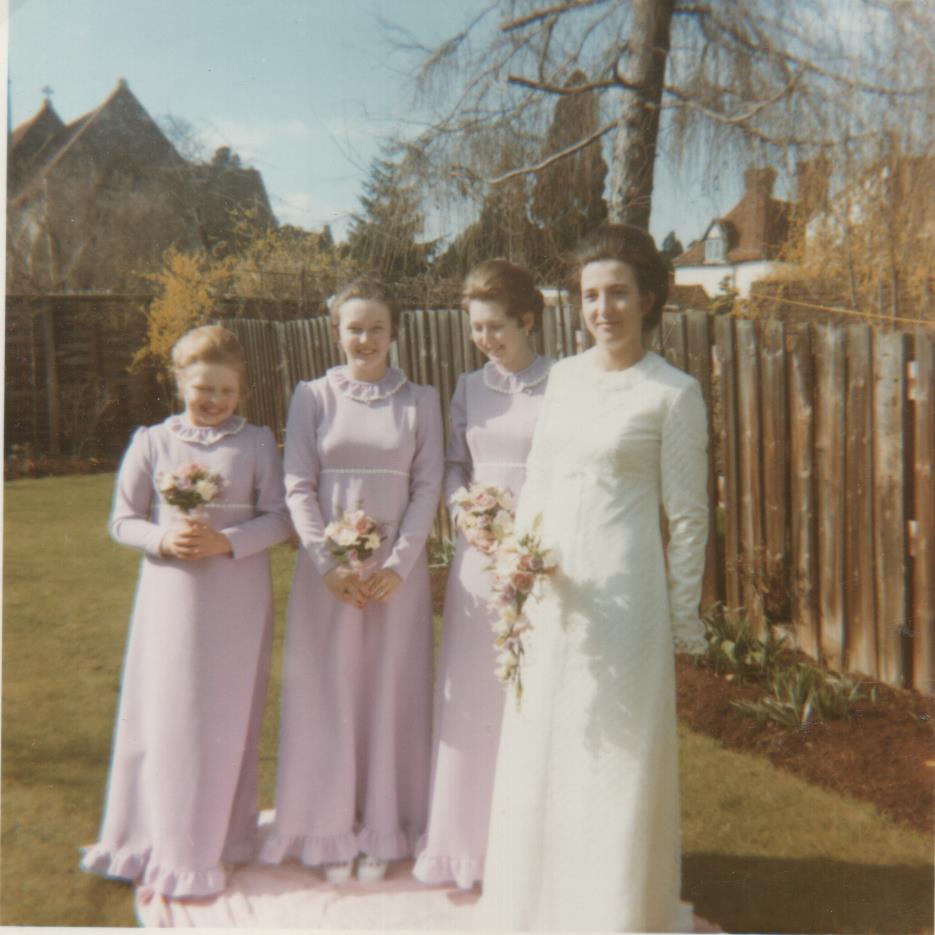
summary
These pictures have been both wonderful to look through and also rather poignant, as my parents’ marriage sadly ended. However it is lovely to see how happy and carefree my mother is in these photographs. And I raise a toast to absent friends who we have unfortunately lost since this happy day.
There’s certainly many things couples of today’s circumstances can take from the weddings of the 1970s. If our parents/grandparents can make it through tough times, then I’m sure we can get through the craziness we’re experiencing right now. It might mean tightening our belts or reevualting plans but going back to basics may not be a bad thing.
sign up to receive the latest posts straight to your inbox
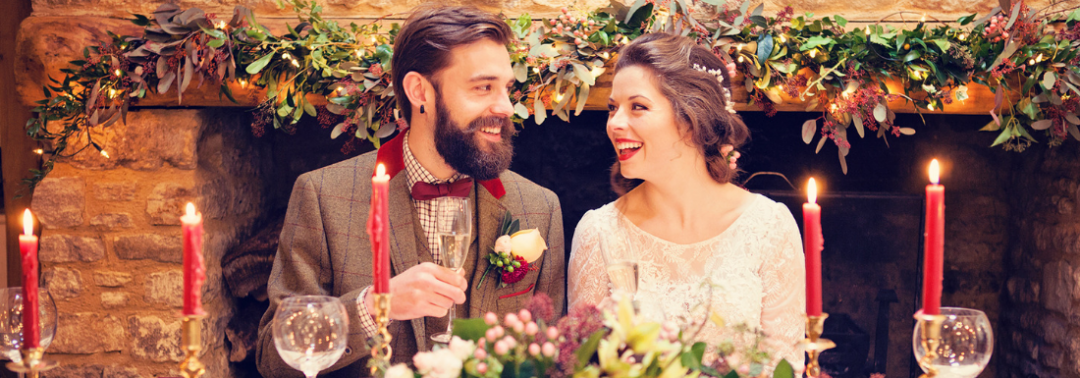
by Hanami Dream | 27, February, 2019 | blog, traditions
There are many traditions, rituals and customs that people uphold and perform in connection with weddings. Some of these have now lost their relevance in modern society and sometimes we are not even sure why we undertake them. However we continue to perform them for fun, family tradition and superstition, especially as many of them have derived from efforts to bestow the happy couple with good luck.
After the ceremony, one of big focal points of the wedding reception is the speeches and toasts. Here’s a quick guide to toasting the happy couple on their wedding day.

Why do we make toasts at weddings?
Traditionally toasts were a way of checking your drink wasn’t poisoned. This custom harks back to the Middle Ages to check that you hadn’t been poisoned by your enemy. A small bit of wine was poured into each other’s glass, clinked so that the wine splashed into the other person’s glass, and then tasted. This is also why often the toast is joined by the phrase ‘to your health’.
Some say that the clink sound was to keep evil spirits at bay. And back in Elizabethan times, an actual bit of spiced toast was put in drinks to flavour it and to soak up the dregs (with the person being honoured receiving the saturated piece of toast).
Nowadays, a toast is used to express and share feelings in words at a special event.
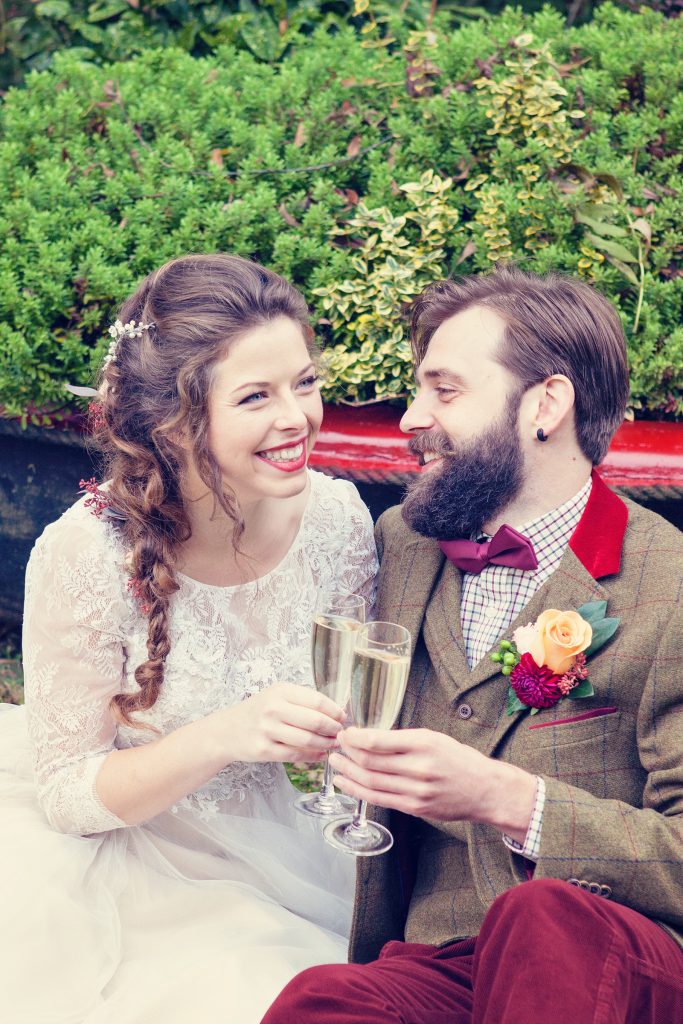
Who makes a toast at weddings?
Traditionally, there are a number of speeches with each ending in a toast. The first of these is a welcome toast performed by the host (often the father of the bride) who concludes his speech by toasting the bride and groom.
The second speech is often by the groom, who finishes by toasting the bridesmaids and attendants. The best man replies on behalf of all the attendants and ends with a final toast to the bride and groom.
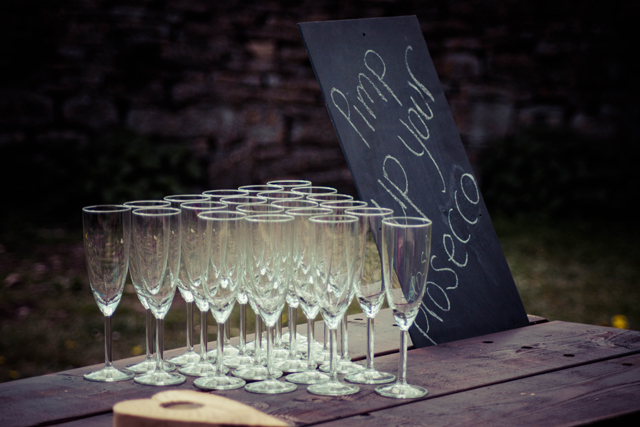
Photography by Thomas Phillips
When do you make toasts at weddings?
Toasts generally follow after the speeches which brings the formal part of the wedding day to an end and is a signal for the informal part to begin.
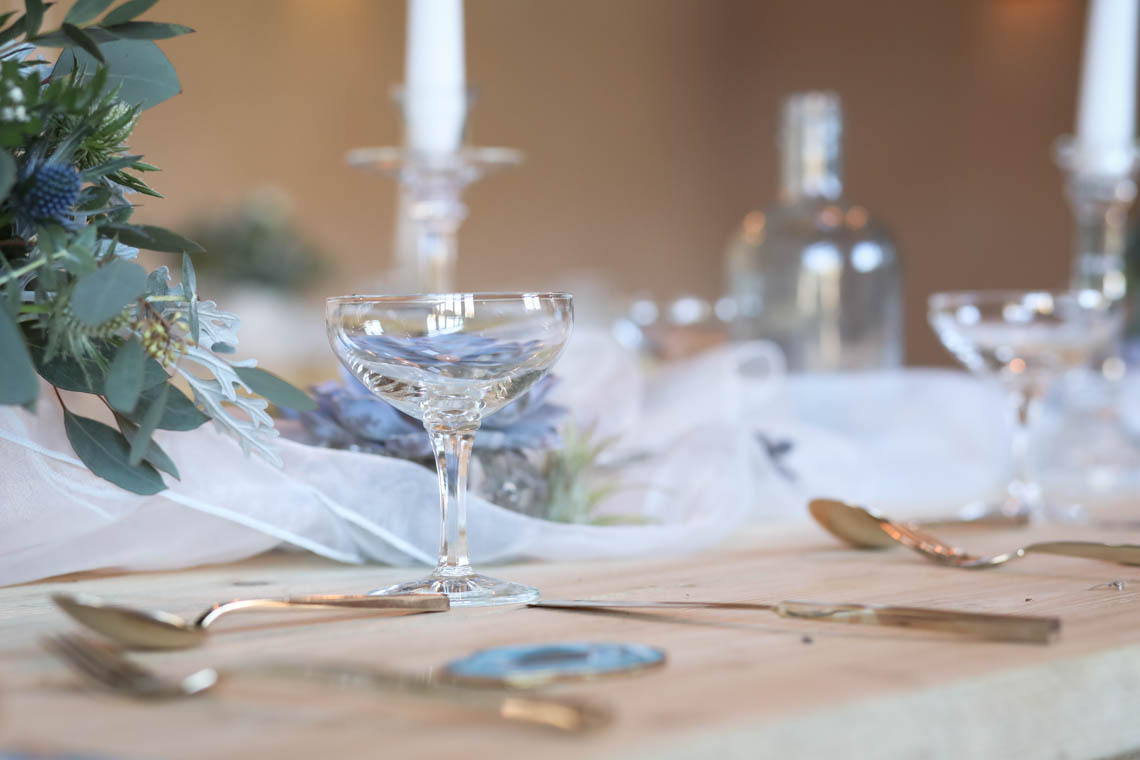
What do you use to make toasts at weddings?
Traditionally a different drink is served for the speeches at a wedding. Guests have their glasses charged and ready to take a sip after each toast. This can be with champagne, sparkling wine or Prosecco. Alternatives for drinks to accompany the toasts could include a shot for each toast, a signature cocktail, sparkling elderflower or have your guests choose their own drink.
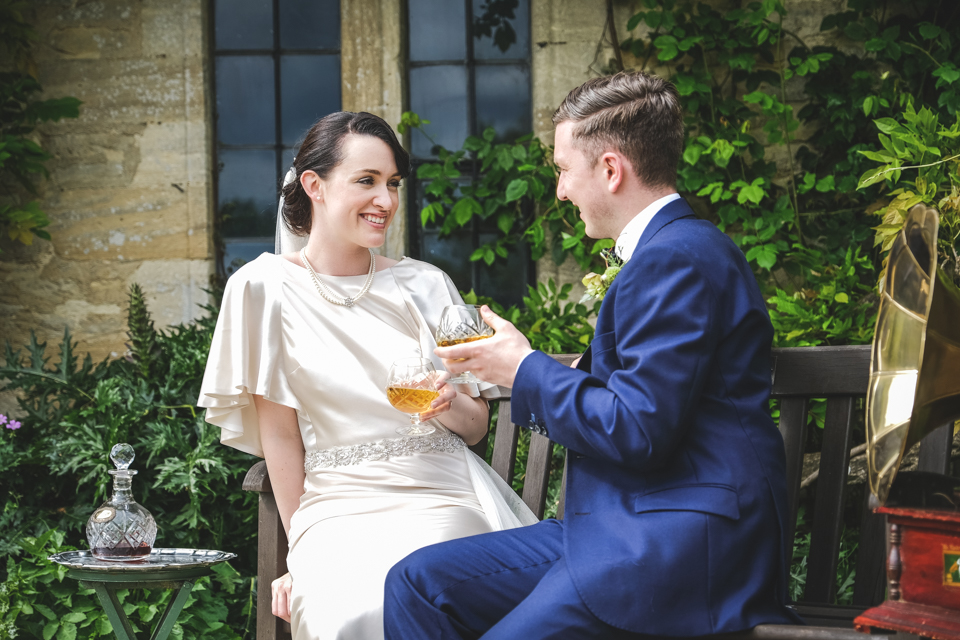
How do you make toasts at weddings?
Originally a toast would be raising your cup as a drink offering to the god(s). This translates now with an arm outstretched with a glass in your hand and saying either: please be upstanding, please raise your glasses, or join me in toasting. Followed by a sentence for everyone else to repeat like ‘to the bride and groom’, ‘to the happy couple, ‘to your health’ or something else as equally poignant.
Cheers!
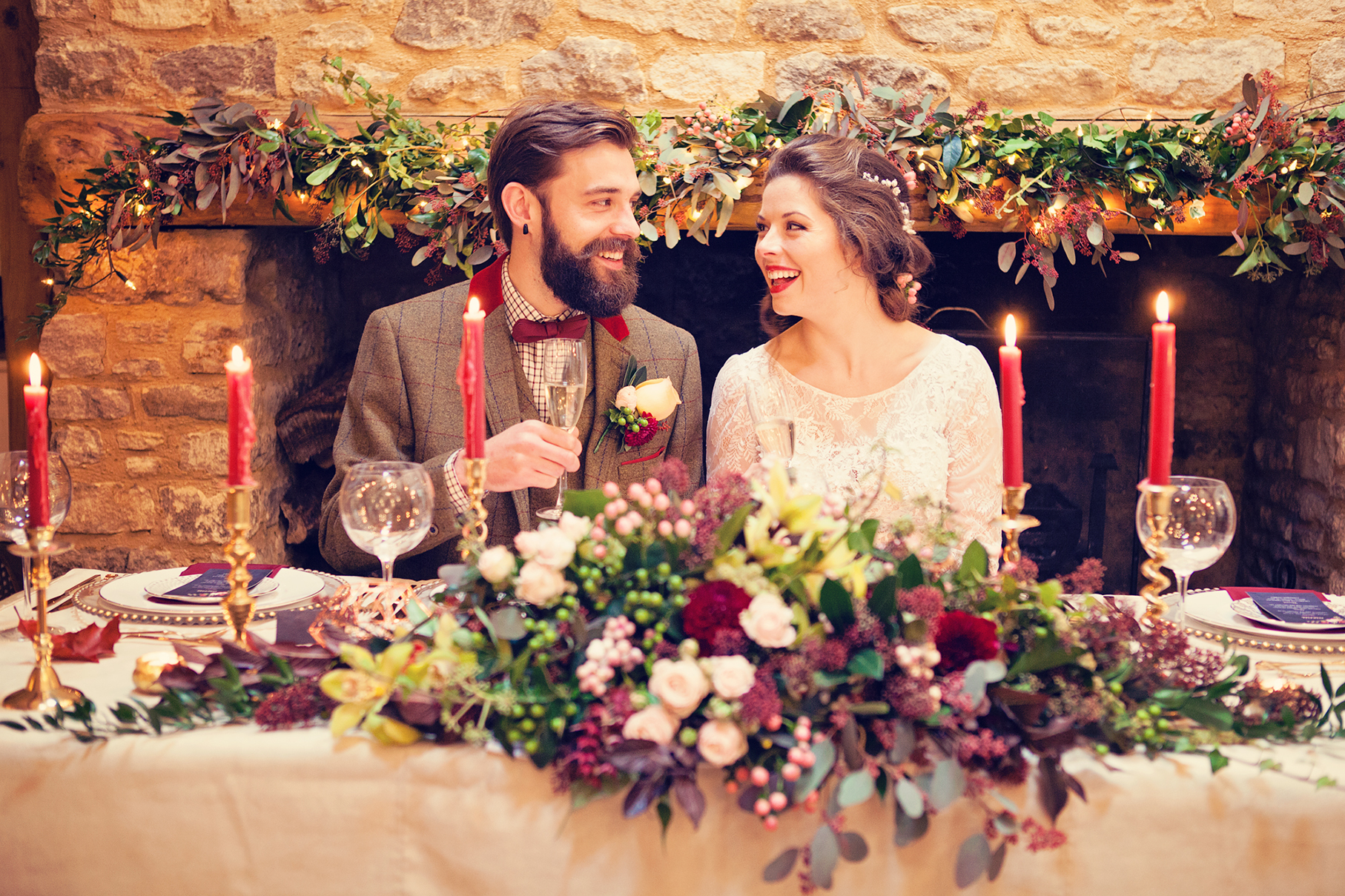
Whichever customs and traditions you decide to incorporate into your big day, Hanami Dream wish you health, wealth, happiness and all the very best in your married life.
Take a break from tradition with this handy guide to modern alternatives to personalise your wedding.
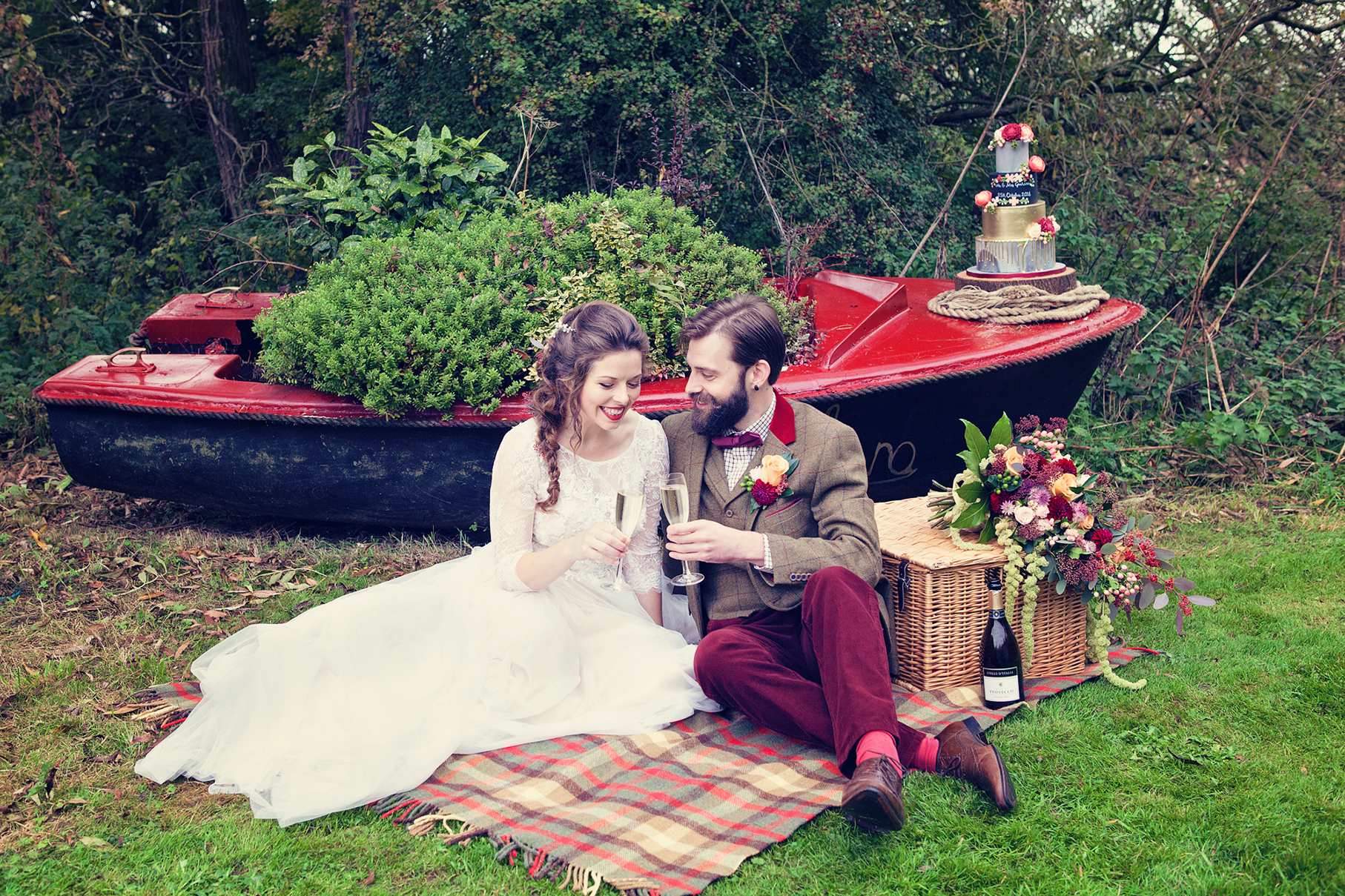
sign up to receive the latest posts straight to your inbox
winner UK Blog Awards 2018
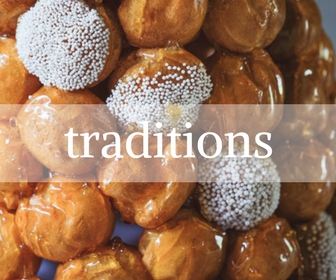
by Hanami Dream | 11, April, 2018 | #UKWedLunch, traditions
#UKWedLunch – Wednesday 11th April 2018
As well as general wedding planning chat, this week there’s a wedding traditions quiz (just for fun!) Tweet your replies (answers at the end of #UKWedLunch)
Here we go… QUESTION 1: What did brides from the east often shave off for their wedding? #UKWedLunch
QUESTION 2: What do Swedish people traditionally do any time the bride and groom leave the table? #UKWedLunch
QUESTION 3: What do German newlyweds have to do in front of their guests? #UKWedLunch
QUESTION 4: An old Scottish wedding tradition is to do what to a bride on the eve of her wedding?#UKWedLunch
QUESTION 5: In English folklore, it is good luck if a bride meets this person on the way to the wedding #UKWedLunch
QUESTION 6: What is placed on top of a wedding cake in Bermuda? #UKWedLunch
Hope you’ve had fun! Here are the answers: A1= eyebrows, A2= kiss, A3= saw a log in half, A4= wash her feet, A5= chimney sweep , A6= cedar sapling #UKWedLunch
Congratulations if you got all the questions correct. See more wedding traditions on Hanami Dream blog https://www.hanamidream.co.uk/category/traditions/ #UKWedLunch
Thank you for all the RTs, follows and likes! Hope to see you again next Wednesday 1-2pm for more wedding planning chat #UKWedLunch
As well as general wedding planning chat, next week will be about wedding photographs #UKWedLunch
JOIN US EVERY WEDNESDAY! on Twitter between 1-2pm GMT

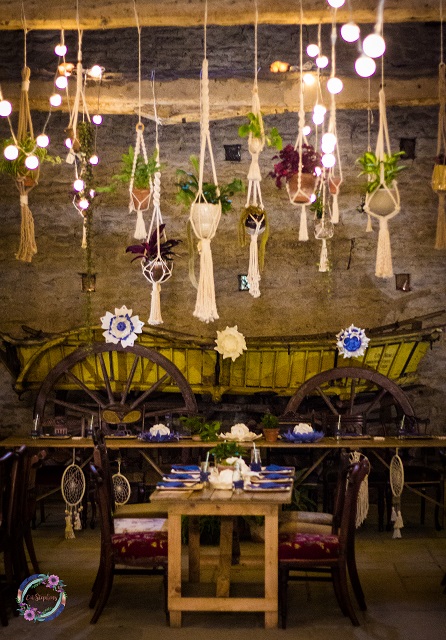
by Hanami Dream | 20, December, 2017 | #UKWedLunch, traditions
#UKWedLunch – Wednesday 20th December 2017
As well as general wedding planning chat, this week there’s a wedding traditions quiz (just for fun!) Tweet your replies (answers at the end of #UKWedLunch)
Here we go… QUESTION 1: What did early Roman brides carry instead of flowers? #UKWedLunch
QUESTION 2: In what year was it first possible to marry in a licensed venue in England and Wales? #UKWedLunch
QUESTION 3: What is not allowed at a civil ceremony? #UKWedLunch
QUESTION 4: What is a traditional French wedding cake? #UKWedLunch
QUESTION 5: What is an Ascot? #UKWedLunch
QUESTION 6: The Wedding March from Wagner’s opera “Lohengrin” is better known as what? #UKWedLunch
Hope you’ve had fun! Here are the answers: A1= herbs, A2= 2000, A3= hymns, A4= croquembouche, A5= cravat, A6= here comes the bride #UKWedLunch
Congratulations if you got all the questions correct. See more wedding traditions on Hanami Dream blog https://www.hanamidream.co.uk/category/traditions/ #UKWedLunch
All the very best for a very Merry Christmas and a Happy New Year! Look forward to seeing you again in 2018 from Wednesday 3rd Jan 1-2pm for more wedding planning chat #UKWedLunch
Having a break from wedding planning chat next week, but there will be a round up of top posts from 2017. Feel free to tweet yours to #UKWedLunch on Wed 1-2pm
JOIN US EVERY WEDNESDAY! on Twitter between 1-2pm GMT

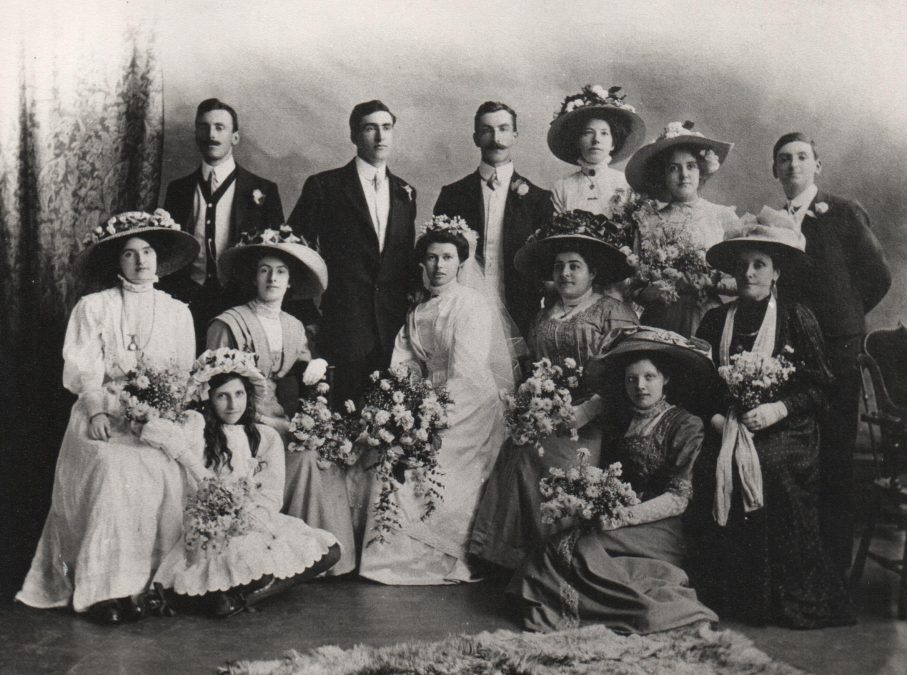
by Hanami Dream | 13, April, 2017 | #UKWedLunch, traditions
#UKWedLunch – Wednesday 12th April 2017
As well as general wedding planning chat, this week there’s a wedding traditions quiz (just for fun!) Tweet your replies (answers at the end of #UKWedLunch)
Here we go… QUESTION 1: Why are church bells rung at the end of a wedding ceremony? #UKWedLunch
QUESTION 2: Which is said to be the unluckiest month to get married in? #UKWedLunch
QUESTION 3: In Victorian times, what did brides use as a code to convey hidden meanings? #UKWedLunch
QUESTION 4: What do Greek brides put in their gloves for good luck? #UKWedLunch
QUESTION 5: In Holland, what is planted outside a newly married couple’s home as a symbol of fertility? #UKWedLunch
QUESTION 6: What would happen if the single guests slept with a slice of wedding cake under their pillow? #UKWedLunch
Hope you’ve had fun! Here are the answers: A1= drive away evil spirits, A2= May, A3= flowers, A4= sugar cubes, A5= pine tree, A6= dream of future spouse #UKWedLunch
Congratulations if you got all the questions correct. See more wedding traditions on https://www.hanamidream.co.uk/category/traditions/ #UKWedLunch
Look forward to seeing you again in next Wednesday 1-2pm for more wedding planning chat and celebrating achievements. All the very best for a very Happy Easter! #UKWedLunch
JOIN US EVERY WEDNESDAY! on Twitter between 1-2pm BST
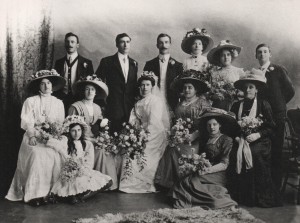
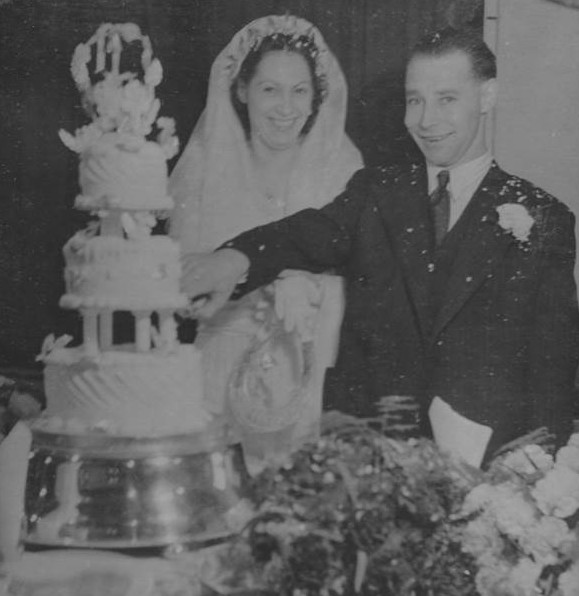
by Hanami Dream | 21, December, 2016 | #UKWedLunch, traditions
#UKWedLunch – Wednesday 21st December 2016
As well as general wedding planning chat, this week there’s a wedding traditions quiz (just for fun!) Tweet your replies (answers at the end of #UKWedLunch)
Here we go… QUESTION 1: What was the original meaning of the word ‘bride’? #UKWedLunch
QUESTION 2: Which is said to be the unluckiest day to get married on? #UKWedLunch
QUESTION 3: Tiered cakes emerged from a game where couples tried to do what over an ever-higher cake without knocking it over? #UKWedLunch
QUESTION 4: If the younger of 2 sisters marries first, what must the older one do at the wedding or risk not finding a partner? #UKWedLunch
QUESTION 5: In Denmark, what would couples dress up as to confuse evil spirits? #UKWedLunch
QUESTION 6: What do Czechs throw at newlyweds instead of rice? #UKWedLunch
Hope you’ve had fun! Here are the answers: A1= cook, A2= Saturday, A3= kiss, A4= dance barefoot, A5= each other, A6= peas #UKWedLunch
Congratulations if you got all the questions correct. See more wedding traditions on Hanami Dream blog https://www.hanamidream.co.uk/category/traditions/#UKWedLunch
Look forward to seeing you again in 2017 from Wednesday 4th Jan 1-2pm for more wedding planning chat #UKWedLunch
All the very best for a very Merry Christmas and a Happy New Year! #UKWedLunch
Having a break from wedding planning chat next week, but there will be a round up of top posts from 2016. Feel free to tweet yours to #UKWedLunch on Wed 1-2pm
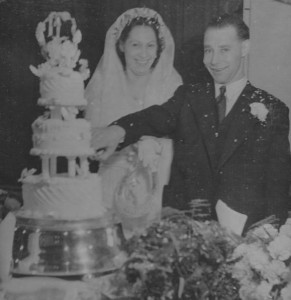
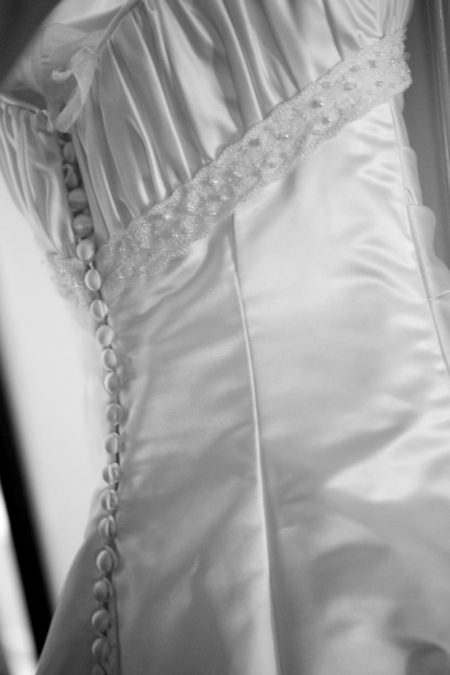
by Hanami Dream | 3, May, 2016 | blog, traditions
There are many traditions, rituals and customs that people uphold and perform in connection with weddings. Some of these have now lost their relevance in modern society and sometimes we are not even sure why we undertake them. However we continue to perform them for fun, family tradition and superstition, especially as many of them have derived from efforts to bestow the happy couple with good luck.
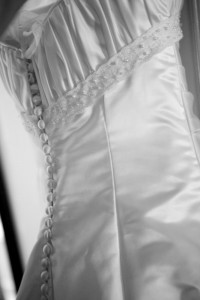
There are many superstitions surrounding what the bride wears (see our post Wedding traditions: Don’t forget the silver sixpence in your shoe!) and it is often said that is unlucky for:
- the bride to make her own dress
- the groom to see the bride in her dress before the ceremony
- the bride to wear her entire outfit before the wedding day
Bridal wear is really seeing a big shift in trends to provide new, innovative and unusual styles to make sure the bride makes a statement and is different to any other on her big day. Trends that are appearing on the catwalks include: mix & match separates, crop tops, high necklines, off the shoulder, asymmetric hems, backless dresses and plunging v necks on the back. For the more daring and alternative bride there’s fringing, jumpsuits, palazzo pants, peakaboo skirts or even capes.
Rather than a plain dress, some brides are opting for a floral one or even camo print (which is starting to be really popular in the US – not necessarily in classic hunting camo but more pink or snow camo, or accessorising the traditional camo with orange accents!) Plus the recent bridal fashion shows for Spring/Summer 2017 also saw a shift towards pastel and even black dresses.
This may seem like a turn away from the traditional white wedding dress, however, it’s not that long ago that white wasn’t the usual colour to wear for your wedding day either. White was actually seen as quite an impractical colour as it would show the dirt and therefore you’d probably only get one wear out of it. So it was seen as a colour worn by the wealthy and not common as a wedding dress colour. Whilst modern culture symbolised white as a pure colour, you nearly always see the Virgin Mary depicted in blue as it reflects calm and purity. In fact, until the 15th century in the UK, white was seen (and is still in some cultures) as a sign of mourning.
Until Queen Victoria in 1840, most British royal brides wore silver. However her beautiful white lace court dress influenced the trend for white dresses in all brides as before this time they would’ve worn their Sunday best dress. In fact, red dresses were often a popular choice and this colour remains popular (and lucky) in Thai, Chinese, Vietnamese, Indian and Korean cultures. Then during World War 2, brides wore nice tailored suits or even their uniforms.
As the wearing of white wasn’t such a common occurrence, it’s no surprise that there was a rhyme to determine which colour would bring the most luck:
Married in white, you have chosen alright.
Married in grey, you will go far away.
Married in black, you will wish yourself back.
Married in red, You will wish yourself dead.
Married in green, ashamed to be seen.
Married in blue, you will always be true
Married in pearl, you will live in a whirl
Married in yellow, ashamed of your fellow.
Married in brown, you will live in the town
Married in pink, your spirit will sink
Whichever customs and traditions you decide to incorporate into your big day, we wish you health, wealth, happiness and all the very best in your married life.
















 About Susie Grist Couture
About Susie Grist Couture





































